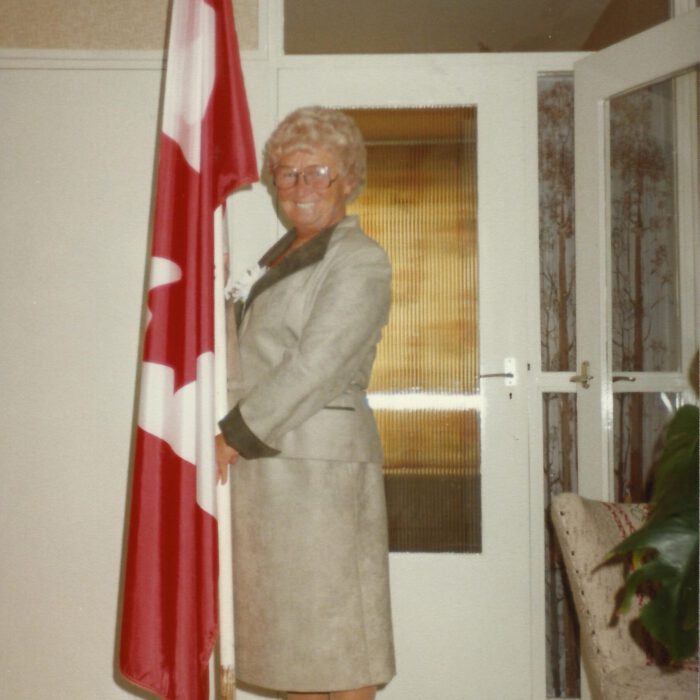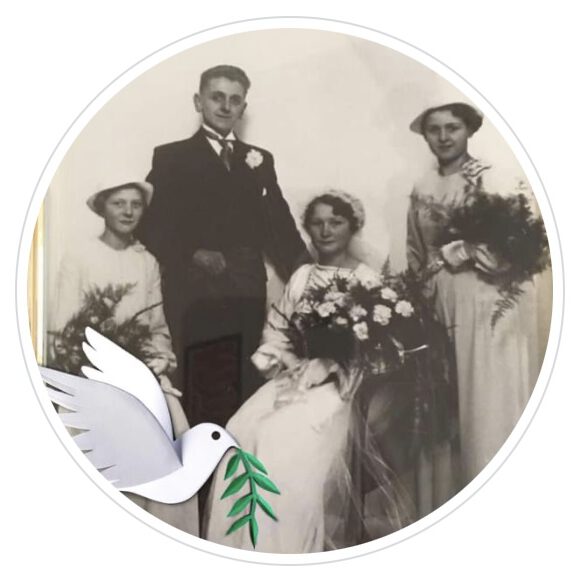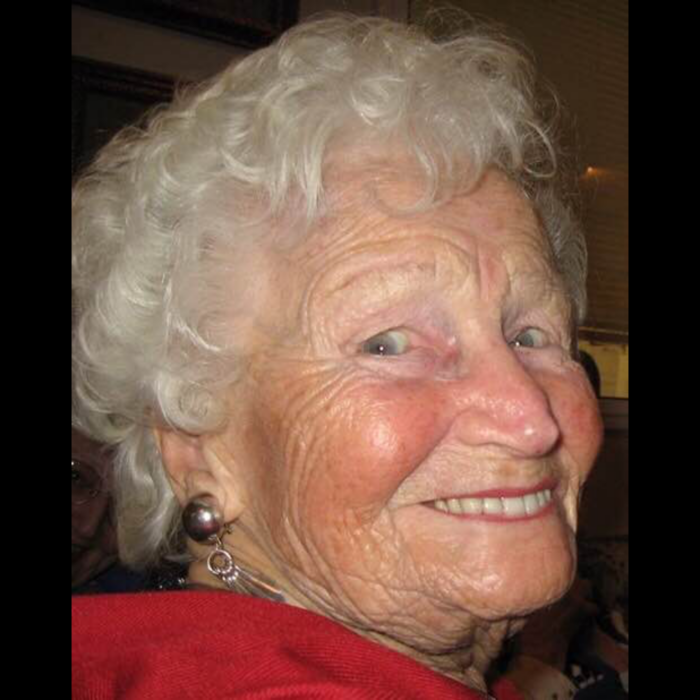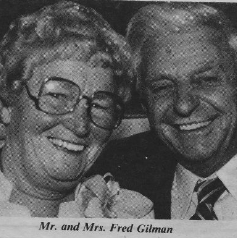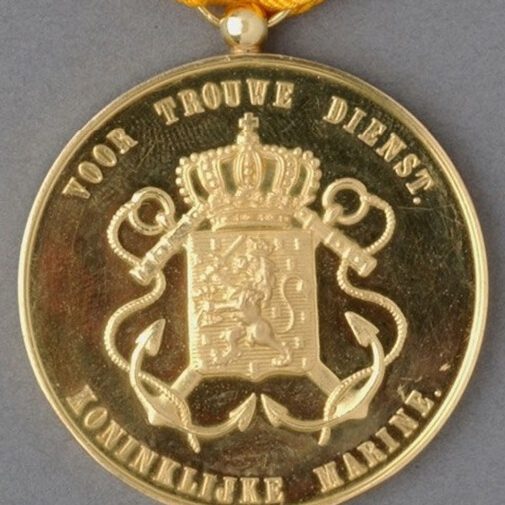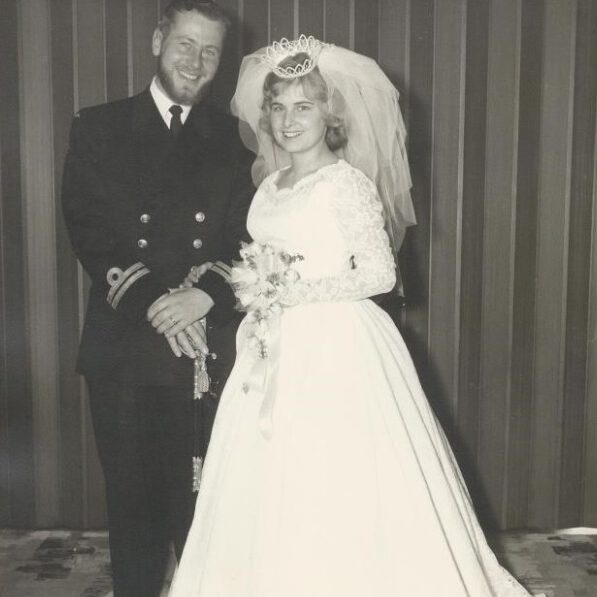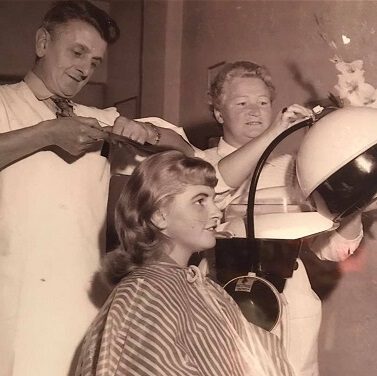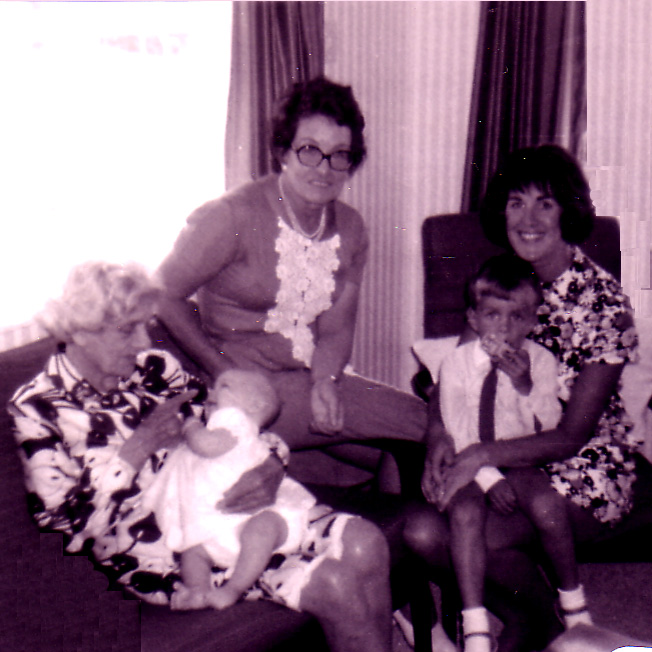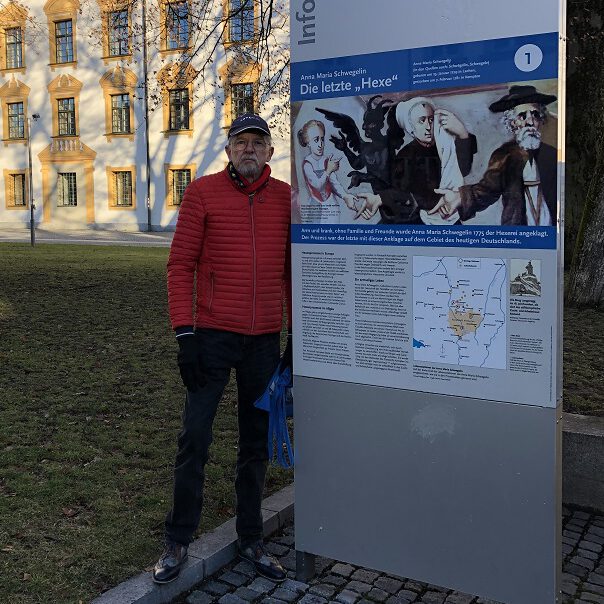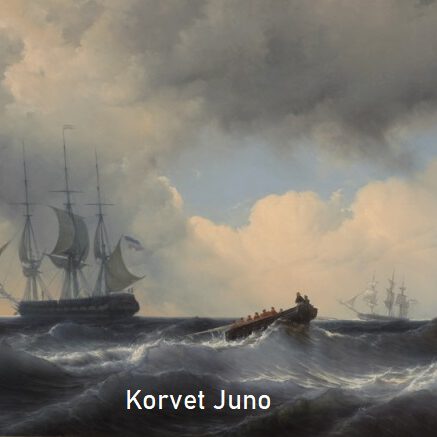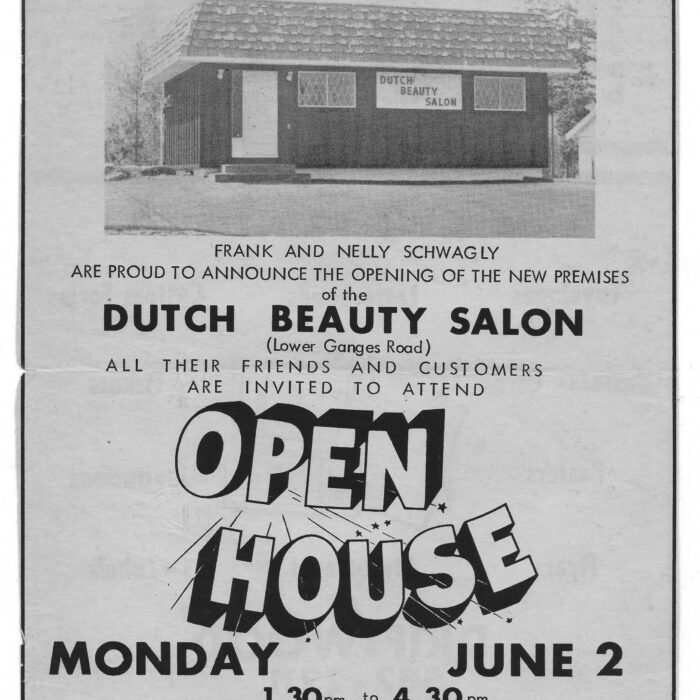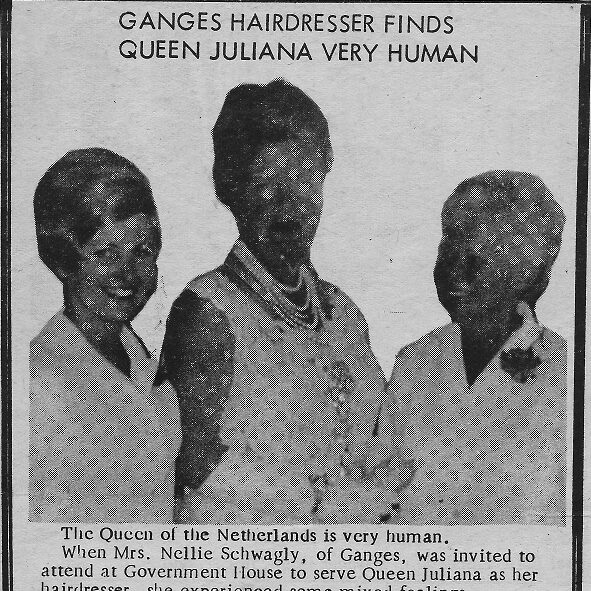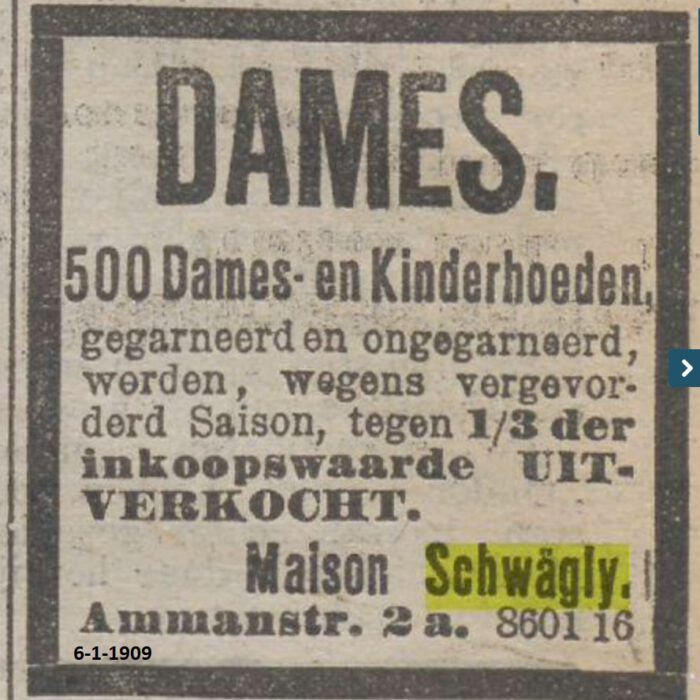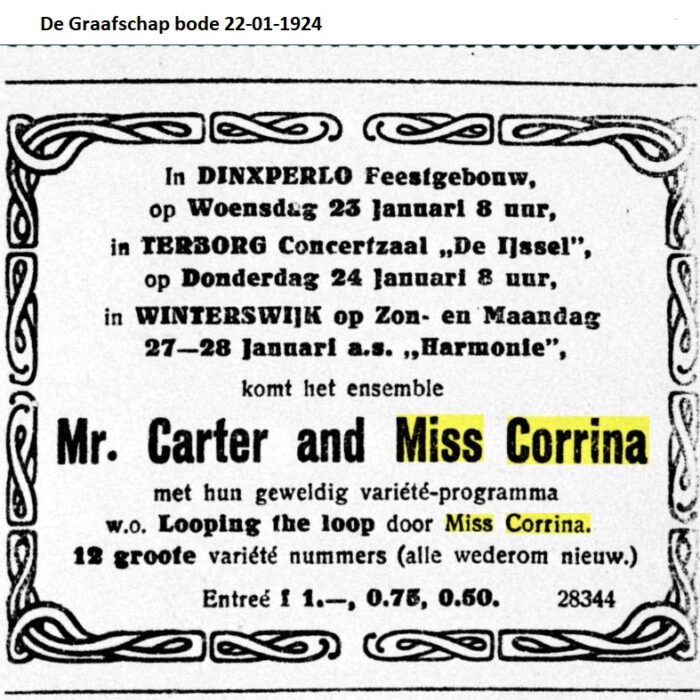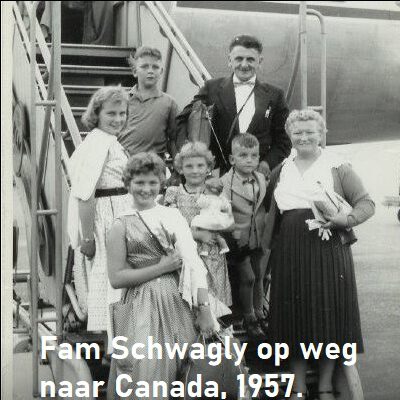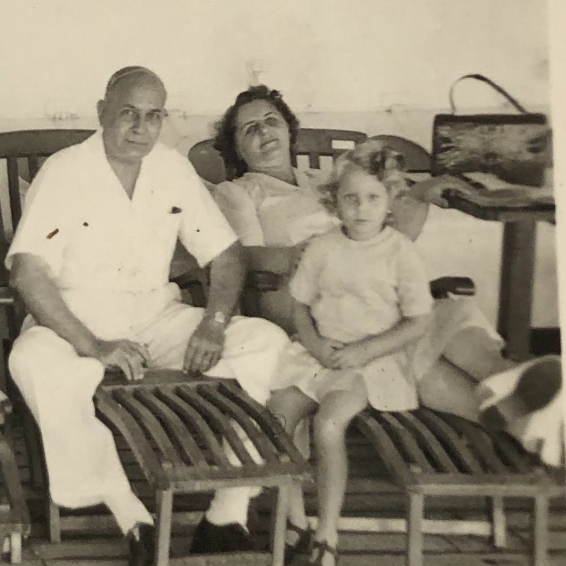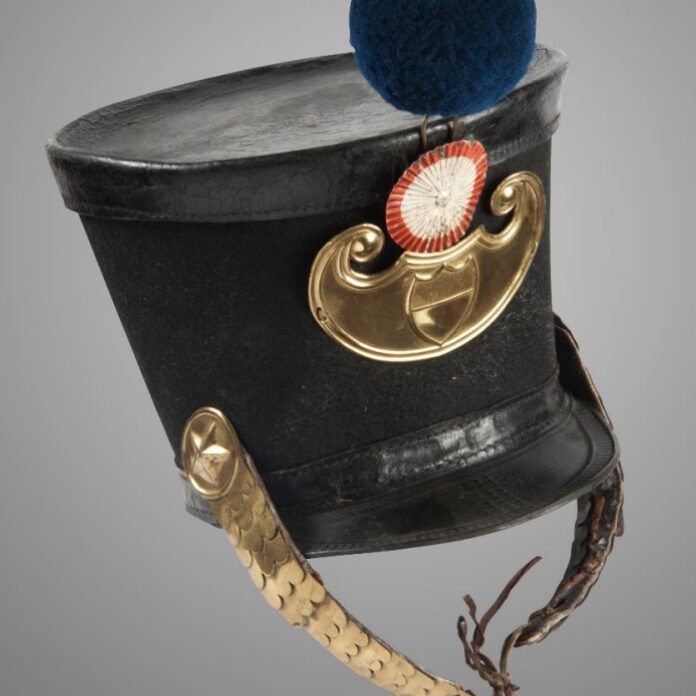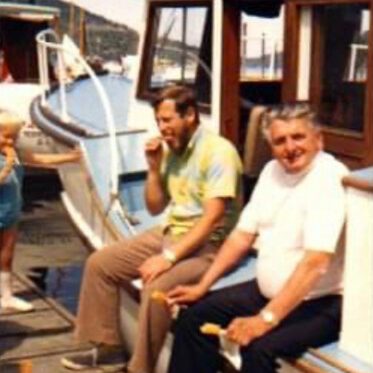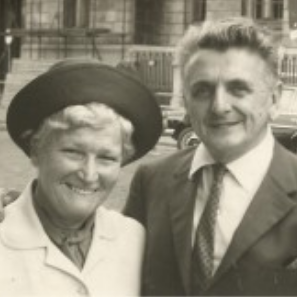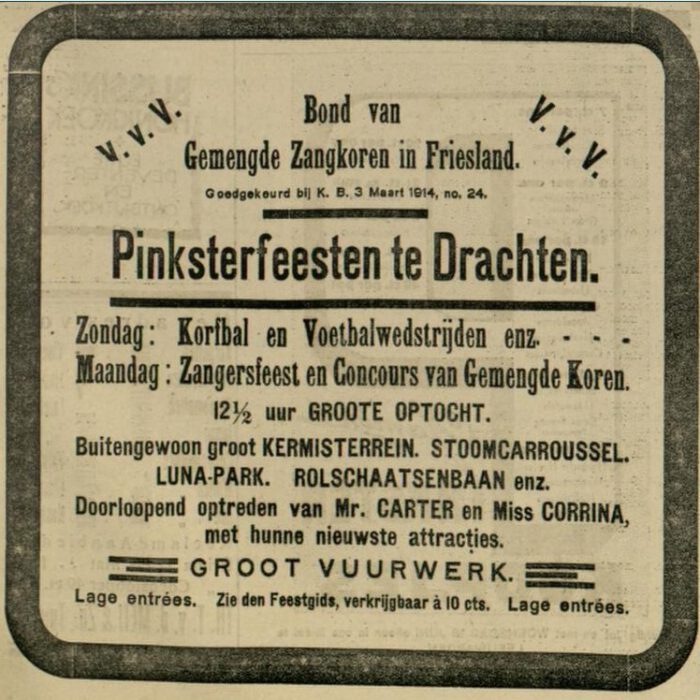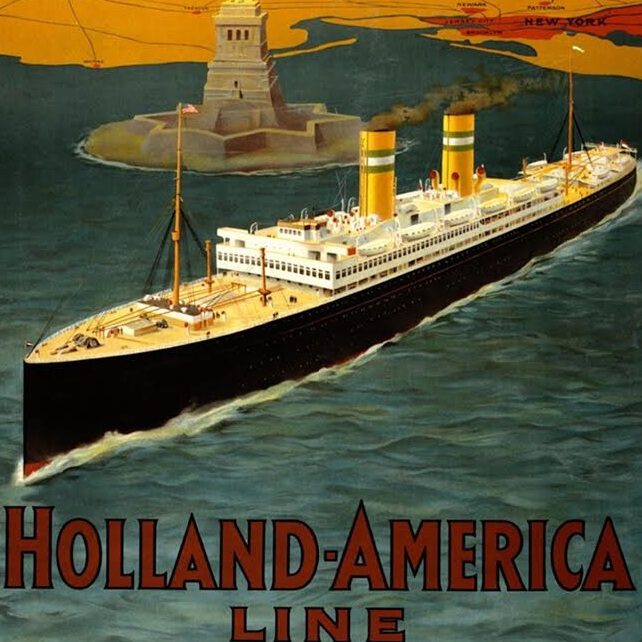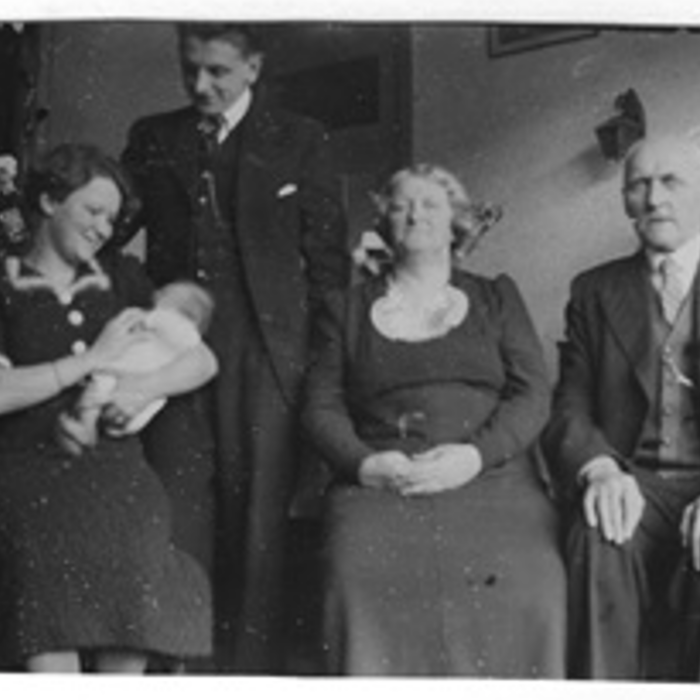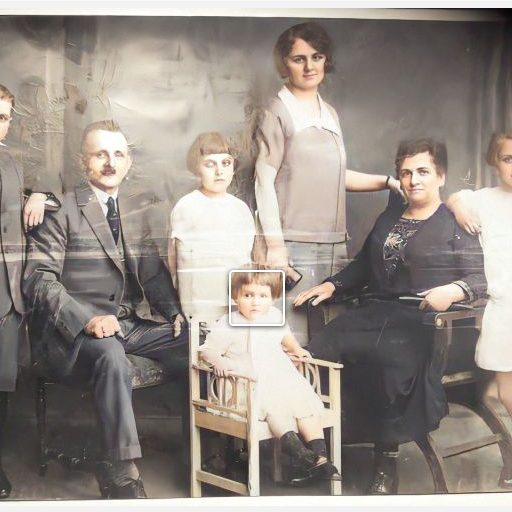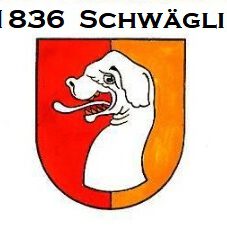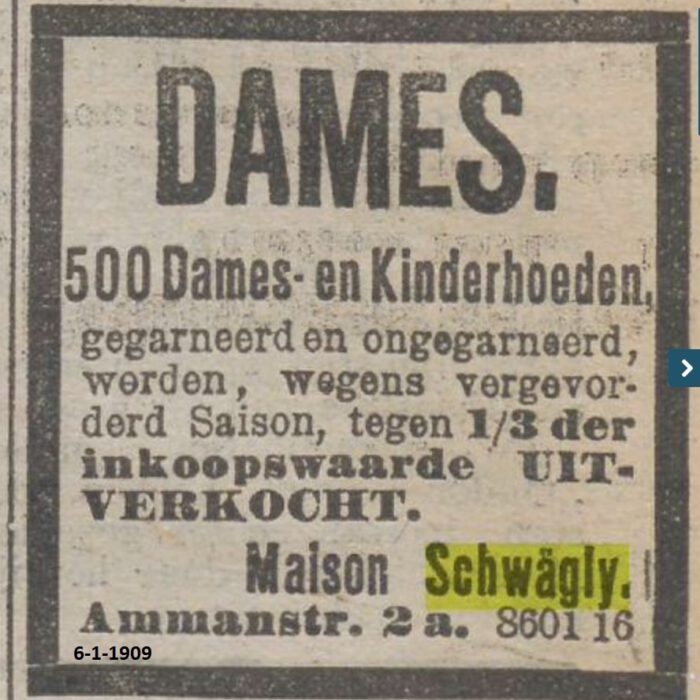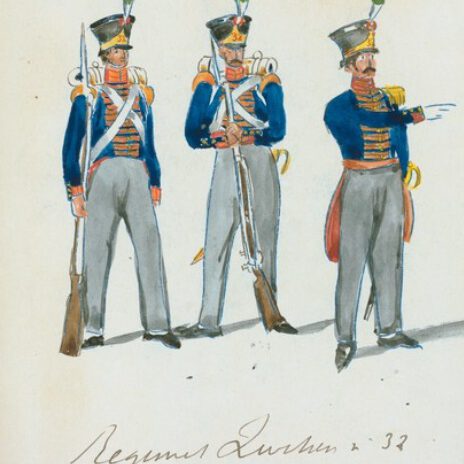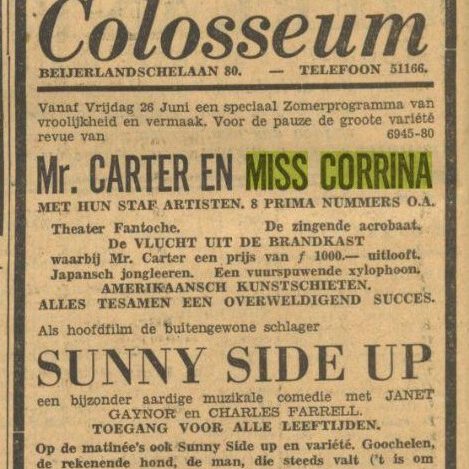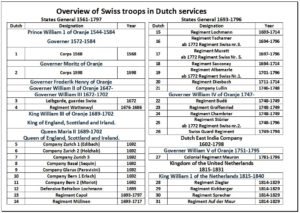Welcome, meet the “Schwägly’s”.
Table of contents:
Introduction
Chapter 1. Urs Victor Franciscus and Victorinus Schwägli’s Parents and Grandparents.
Chapter 2. The martyrs St.Ursus and St.Victor.
Chapter 3. The history of the Swiss Soldiers in the Netherlands.”
Chapter 4. The life story of Urs Victor Franciscus Schwägli.
Chapter 5. The life story of Victorinus Schwagli.
Chapter 6. The fourth generation of Schwäglij’s with Franciscus Johannes Schwäglij.
Chapter 7. The fifth generation of Schwäglij’s, and the children of Franciscus Johannes Schwäglij.
Chapter 8. Mr Carter and Miss Corrina.
Chapter 9. The sixt generation of Schwägly’s.
Chapter 10. The search continues
Chapter 11. The Last Witch.
Notes with genealogical data.
Welcome, meet the “Schwägly’s”.
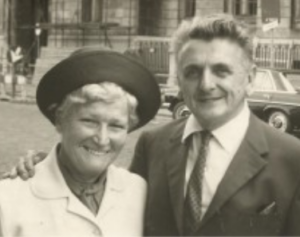
My mother’s sister, “Nel Tenholter” married in 1936 in Rotterdam with Frans Schwägly. This not very common name of Schwägly was the reason for me to find out where did this name come from? It was a fun search, and what a great family history. You will come across a lot of handsome people, a witch, a modiste, soldiers, a gunner-major, a tax-controller, a captain, cooks, bakers, a fish-merchant, hairdressers, an actress and an artist. A many-coloured compilation of people, which gives this family tree and story an extra dimension. But let us not forget all died young children in this family and the family members who died during the Second World War, they are also a part of this ” Schwägly family story”.
May they rest in peace and rise in glory. We keep in prayer the souls of the faithful departed, with God there is mercy and forgiveness.
Into your hands O Lord we. entrust our brothers and sisters, family, and friends. In this life you embraced them with your tender love;
Go dear family and friends, the Lord of Divine Mercy is calling your name. Your victory has been won.
Introduction
We will make a leap of two hundred years back in time, it was in the year of 1819. And it was in the month of March that Urs Victor Franciscus Schwägli, 28 years old, was sitting on the banks of the river Aare near the Swiss city of Solothurn, and his thoughts were about his life and future. He observed the beautiful city, the St.Ursus Cathedral, the Town Hall, the Clocktower, the old arsenal, the guild houses and the Jesuit-Church.
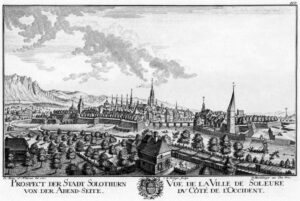
Two weeks ago, he had signed for four years, for the Dutch army, after a call from General-Major Auf der Mauer in the Town Hall. So now it was really happening, were he so long had been waiting for. Tomorrow he would say goodbye to his parents, his two younger brothers, his four sisters and of his beloved city of Solothurn, to leave for the depot in Lucerne and from there with a company of Swiss soldiers to the unknown Holland.

He looked at the bridge over the gently lapping water of the Aare, and smelled the burning wood of the ovens from the lime and brick yard of Jacob Veber. In the distance a hot air balloon of the brothers Tschann went up. For years they were building and testing all kind of balloons in their barn in order to be able to travel by air. It was a beautiful view to see the balloon moving along the bright golden horizon and the mountains of the Jura.
When he was a little boy and with his parents on the market-square of Solothurn, Urs Victor had looked full of admiration at the statue of the golden knight Ursus in the middle of the fountain.
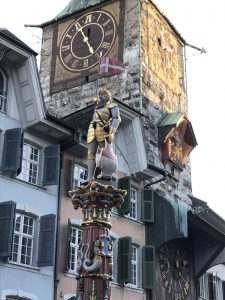
He knew it, “later I want to be a knight”. He had looked so long, that he almost lost his parents in the hustle and bustle of the market. In the year 1798, Urs Victor was seven years old, the French conquered the canton of Solothurn. The population took it patiently, and there was not a lot of resistance from the soldiers and the bourgeoisie.
The inhabitants of Solothurn were good-natured for the French, also due to the fact that the ambassador of France was already living there for years. The French soldiers had expected more resistance from the city, so they had fired some cannon balls into the city, and caused some damages, but fortunately the damages on the beautiful baroque city center were very small.
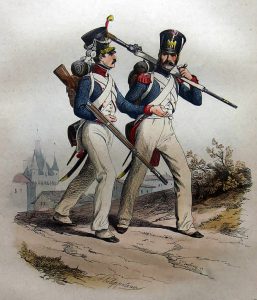
Urs Victor was full of admiration for the French soldiers, when they marched in their beautiful uniforms through the city. Their white trousers, the high boots, their long blue jacks with white stripes, brass buttons and golden epaulets, and not to forget their sjako’s (hats) with the red plumes on top.
Urs victor and his friends, Anton and Jacob tried to imitate the soldiers, they walked with really big steps behind the marching trumpeters and drummers, all bystanders had to laugh at this cheerful scene. The next months when the Jezuit-school was finished the boys played like “soldiers” with the old wooden rifles of their granddad.
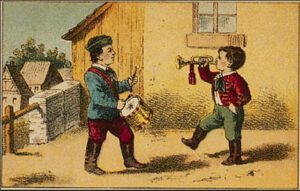
With fourteen, his father told him, that there was no money to go to the military academy in Solothurn, and that he had to start working as farmhand in the fields. With eighteen years Urs Victor served for one year in the Swiss army, he learned to shoot very well, which helped him later to win nice prices on the annual shooting competitions and festivals in Solothurn. After his serving year with the army, his father helped him, to get a job on the “estate Bloemenstein” from the family Wallier. The last number of years he had been working in the rifle-factory in Solothurn, but he did not like this job, working between four walls, he wanted to explore the wide world.
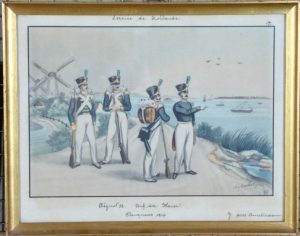
First he tried to join the French army, but since a number of years the wages of the Dutch soldiers were higher, and the soldiers, who came back now were telling fantastic stories about their experiences in Holland. They had talked about the Dutch ladies, the Dutch beer and about the windmills, the dikes, and the canals of Amsterdam.
Urs Victor heard the clock of the Ursus Cathedral strike four hours, he went home, but not before he had say goodbye to his friends in the tavern and brewery “Sternen”. Tomorrow will be a long day !!
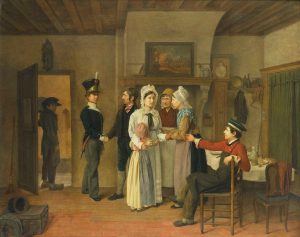
This was a short impression, of how the first years of the life of Urs Victor Franciscus Schwägli could have been, but now the real facts of the family Schwägli from what I found in the old archives and newspapers and all the news from oral tradition.
The name “Schwägly” is written in various ways. In the 18th century we find the name in Austria, Switserland, France and Germany, written as “Schwaglin“, probably a corruption of Schwäglein which means weak or sickly, but it is also possible that “Schwägly” is a corruption of Schwägerin which means sister-in-law! There are still persons living in Switzerland with the name of Schwägli and Schwäglerin.
In 1947 according to the Dutch family name index, (https://cbgfamilienamen.nl/nfb/) there were 11 people living in the Netherlands with the name “Schwägly”, 3 in The Hague and 8 in Rotterdam, not much then on a population size of 10 million inhabitants.
Chapter 1. Urs Victor Franciscus and Victorinus Schwägli’s Parents and Grandparents.
As of 1650 we found the name “Schwägli” in and around the place Solothurn in Switzerland written in various ways: Schwägli – Schwägly – Schwäglij – Swäglj – Zweglij – Schwaegli and Schwaegeli, with or without colon (double dot) whereby the German ä is pronounced as “e”.
The first three genrations of Schwägly’s:
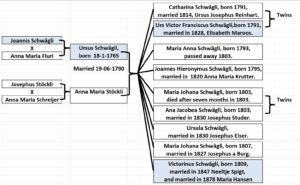
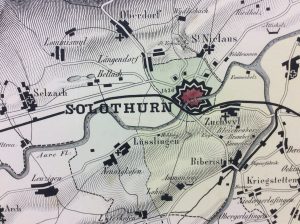
When I was searching for the Schwägli’s in the Dutch archives, I found out that the Schwägli’s came from Switzerland. Two brothers, Urs Victor Franciscus Schwägli and Victorinus Schwägli had gone to the Netherlands as mercenaries and stayed there. To find out more about these two brothers I had to search in the Swiss archives. Both brothers were born in the town of Oberdorf near the city of Solothurn.
The church of Oberdorf where they were baptized, started with keeping track of baptism, marriage and death records as of the year 1593, and copy’s of those records were available for inspection at the Mormon Church here in Amsterdam.
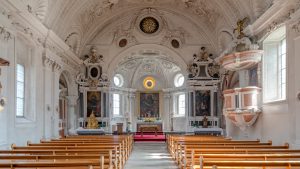
But the hand-writings in 1600 were very difficult to read, and the information was very poor, sometimes when a couple was married, the priest in the church noted only the date and the names of the bride and groom! Later they started to note also the names of their parents, and witnesses.
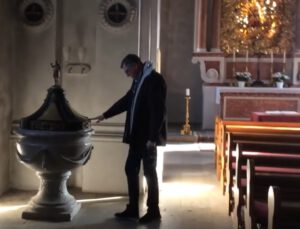
In the winter of 2019 i visited the City of Solothurn and found out more in the city-archives .In the marriage book of Solothurn from 1731 to 1790 i found that the grand-parents of Urs Victor Franciscus and Victorinus were Joannis Schwägli and Maria Anna Fluri, and their parents were Ursus Schwägli and Anna Maria Stöckli, They married on the 19th of June 1790. the marriage certificate translated from Latin read as follows:
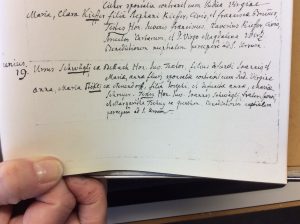
“Ursus Schwägli (1), from Bellach, son from Joannis and Maria, Anna Fluri, is getting married with Anna, Maria Stöckli, from Neuendorf, daughter of Josephus, and Anna Maria Schreijer. Witnesses are Joannis Schwägli, brother of the groom, and Margaretha Tschuij”. Ursus Schwägli and Anna Maria Stöckli had nine childeren.

Nine months after their marriage, a son and daughter (twins) were baptized in the parish and pilgrimage church “Our Lady of Oberdorf” in Oberdorf, (2), and they became the names: Urs Victor Franciscus and Catharina. More about Urs Victor Franciscus Schwägli in Chapter 4.
His twinsister Catharina married 23 years old with Ursus Josephus Reinhart, (3). Two years later in 1793 Maria Anna was born, she died ten years old, (4). And another two years later in 1795 Joannes Hieronymus was born, he married 25 years old with Anna Maria Krutter, he died with the age of 70 in 1865, (5). In 1803 twinsisters were born Maria Johana and Ana Jacobea, Maria Johana died after seven months, and Ana Jacobea married 27 years old with Josephus Studer, (6). Ursula, I could not find her birth certificate, but she married in 1830 with Josephus Elser, there is noted: daughter of Ursus Schwägli and Anna Maria Stöckli, (7). In 1807 Maria Johana was born, she married 20 years old with Josephus a Burg, (8).
In 1809 Victorinus Schwägli is born, more about him in Chapter 5, (9).
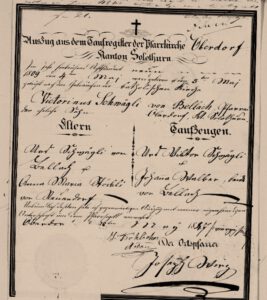
In the 18th century, between 1701 and 1800, more than 15 families were living, in Solothurn, Bellach and Oberdorf, with the fathers name of Schwägli, still more research is here needed.
Chapter 2. The martyrs St.Ursus and St.Victor.
The village of Oberdorf belongs to the city of Bellach, and Bellach is part of the Canton Solothurn, with the same named capital city.
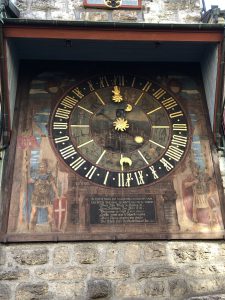
Solothurn is situated at the foot of the Jura mountains, to the north of the city is the “Hausberg” of Solothurn with the 1395 meter high Weissenstein mount. Solothurn calls itself the most beautiful baroque city of Switzerland. The center is dominated by the St.Ursus Cathedral.
Ursus (Urd) Schwägli and Anna Maria Stöckli hit the nail on the head, by naming two of their sons Urs Victor Franciscus and Victorinus, or was it at that time a common practice among Catholics to name sons after these martyrs?
Ursus and Victor where two Roman soldiers from the Thebäische legion. As Christians they refused to worship the gods of Rome, and around 300 A.C. they had escaped from a massacre near the Canton of Wallis, and fled to Solothurn, but at the end Ursus and Victor were decapitated in the Castle of Solothurn.
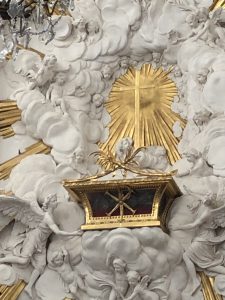
Starting from the year 500 there was a St.Ursus Church in Solothurn, but there is no proof on paper. The first written proof of a St.Ursus Church is dated the year 1293. During a renovation of the church in the 15th century the skeletons of the martyrs Ursus and Victor were found under the altar. In the 18th century they build a new church, which was ready in the year 1773. In the year 1828 Pope Leo XIII gave a bishop’s see and the church became a Cathedral. Ursus of Solothurn is now the patron Saint of the Cathedral.
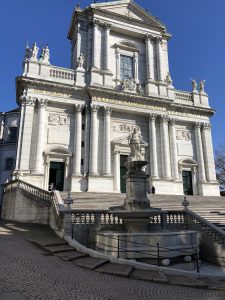
Not far from the Cathedral on the “Marktplatz” (Marketplace) is now a fountain with the statua of the Saint Ursus reprecenting as a knight. Since both sons were named after the martyrs, saints or knights, it is not strange that both sons Urs Victor and Victorinus joined the 32nd Regiment of Swiss Soldiers, which came to the Netherlands to help the new King William I to build a new army to protect his new Kingdom Holland.
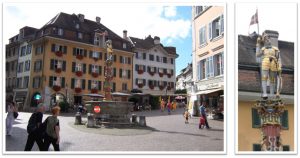
Link to the Tourist information of the city of Solothurn.
Chapter 3. The history of the Swiss Soldiers in the Netherlands.
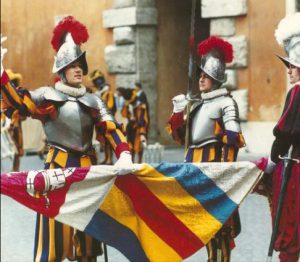
We all know about the Pope’s Swiss Guard in Rome, but what do we know about the Swiss soldiers in the Netherlands? I found in the library of the University for Science and Technology of Zurich, in a magazine form 1916, an interesting article about the Swiss soldiers in the Netherlands, (10).
Here a résumé. For more than hundred fifty years, thousands of Swiss soldiers came to the Netherlands. It was the year 1687, France was under the King Lodewijk XIV constantly busy with enlarging his territory, and therefore England and the States of Holland started negotiations with Switzerland, to recall the Swiss soldiers out of the French army, and to start a convenant to recruit Swiss soldiers for the States of Holland. In 1692, After long negotiations, the first Swiss soldiers came to Holland. First 4 companies of each 200 men, and in 1693 another 4 companies, and later 3 regiments from Bern of a total of 3200 men, and another regiment from Bünden. They all joined fighting against France, and after the “Vrede van Rijswijk” (peace-negotiations) in 1697 they stayed in garrison in different cities of Holland. At the beginning of 1701, when again a war broke out with France, there were 11.200 Swiss soldiers in Holland. The soldiers got a good payment, because of the Dutch prosperity the wages in the States of Holland were the highest. In 1712 with the “Vrede van Utrecht” (Peace of Utrecht) the Southern States of Holland became a part of Austria, but the Swiss soldiers stayed in their garrison in the Southern cities.
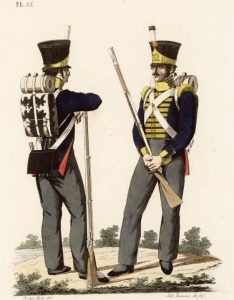
At sea Holland and England were fighting against Spain, these wars absorbed a lot of money, and Holland became a poor country. The Swiss soldiers got their wages after three years but with 6 % interest. And the Swiss regiments were reorganised, in 1715 there were 58 companies of each 100 men left and they got divided into 4 regiments.
In 1742 the Empress Maria Theresia of Austria started a war against Pruisen, France and Spain, and France conquered the Southern States of Holland including the city of Bergen op Zoom, so the Dutch and Swiss soldiers withdraw into the Northern States of Holland. With the “Vrede van Aken” (peace-negotiations) in 1748, the Southern States of Holland became a part of Austria again! Under the authority of Stadtholder Prince William of Oranje, a conflict started in Holland between the Oranje-minded inhabitants and the Patriots, but the Swiss soldiers stayed neutral.
To watch over the Dutch settlements in South Afrika, Sri Lanka and Ceylon, a whole regiment of Swiss soldiers served as of 1780 in the V.O.C. (United East-Indies Company) In the history of the V.O.C, more than 7000 Swiss soldiers served in the East Indies Company.
At the end of the 18th century, with the start of the French Revolution there were 5 regiments of each 1200 Swiss soldiers in the States of Holland. As of 1792 France was again in war with the States of Holland, and also the Swiss soldiers were involved. The border between France and the Southern States of Holland was constanly moving up- en downwards, But in the strong winter of 1794 the French soldiers could easily cross the frozen rivers and conquered the States of Holland. Stadtholder Prince William of Oranje fled on the 18th of January 1795 to England, and a lot of Swiss soldiers went home to Switzerland or moved over into the French army. The States of Holland had to pay a debt to France of 100.000.000 guilders.
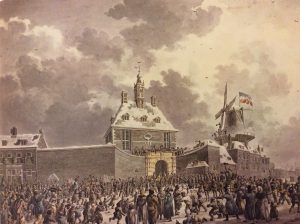
On the 5th of June 1806, the French Emperor Napoleon Bonaparte, made his brother Lodewijk Napoleon King of Holland, and so Holland became a Kingdom. Lodewijk did some good things for Holland, he made criminal laws, started with plans to reclaiming the land of the lake Haarlemmer-meer, but he also made some mistakes, when England tried to conquer Zeeland he started negotiations, Napoleon was not happy with his brother, so the time for Lodewijk in Holland was finished on the 1st July 1810, and Holland became a part of the Empire France.
In 1812 when Napoleon started his big campaign to Russia, with an army of more than 500.000 soldiers, were among them 15.000 Dutch soldiers and another 15.000 Swiss soldiers. The expedition to Moskow ends in a disaster. The strong winter, the shortage of supplies and the Russian strategy of burning down and pulling back had only one outcome: “Only 10% of the soldiers came back out of Russia”.
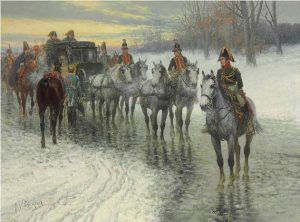
The era of Napoleon was over, when he was defeated in 1815 at Waterloo. The son of the Stadtholder Prince William of Oranje who has fled to England, became King William I, of the Southern states (later Belgium) and the Northern States of Holland, (Verenigd Koninkrijk der Nederlanden). King Wiliam I, wanted to build a new army, so after consulting the Swiss cantons, capitulations (verdragen) for the Dutch army were closed for 4 regiments of each 2005 men, divided into 2 batallions of each 10 companies.
The first regiment No 29 came under the command of Colonel Johan Ludwig Nicolaus van Jenner, with soldiers from Bern.
The second regiment No 30 came under the command of Colonel Christoph van Ziegler, with soldiers from Zürich, Schaffhausen, St.Gallen, Aargau and Thurgau.
The third regiment No 31 came under the command of Colonel Jacob von Sprecher with soldiers from Graubünden.
The fourth regiment No 32 came under the command of Ludwig d’auf der Mauer, with soldiers from the Catholic Swiss cantons: Lucerne, Solothurn, Ticino, Nidwalden, Schwyz, Zug and Uri.
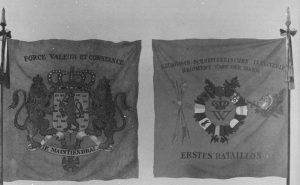
Chapter 4. The life story of Urs Victor Franciscus Schwägli.
The eldest son of Ursus Schwägli and Anna Maria Stöckli, Urs Victor Franciscus was baptized on the 20th of February 1791 in the village of Oberdorf, (together with his twin-sister Catharina).

When he was seven years old (1798), the boy was witness of the occupation of Switzerland by the French. France tried founding the “Republic Helvetia”, but after a short civil war in 1803, this was again abolished, and the autonomous Cantons remained to exist. But there was still infighting between the Catholics and Calvinists cantons. With the “Congress of Vienna” in the year 1815 was the perpetual neutrality of Switzerland acknowledged by Europe’s great-powers.
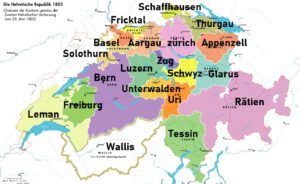
After his school years, I can imagine that Urs Victor wanted to see more of the wide world, in Solothurn there was only a rifles-factory, a socks and textile factory, some trade in salt and some agriculture. Mercenaries were highly demanded, for France, Holland, Spain, Naples and England, and a lot of young man from Solothurn joined the French army. May be he worked in one of the factories or was farm-hand on a farm, or joined a number of years in the French army, but on the 6th of January 1819, the 28 years old Urs Victor signed for the Catholic Swiss Regiment Infantry number 32 of King William I of the Netherlands. This regiment was under command of General-Major Louis d’Auf der Mauer.
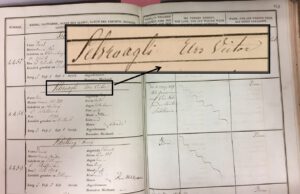
In this period, it was an honor to fight for the Dutch Army, and a lot of sons of rich farmers joined the army. We found Urs Victor Schwägli in the recruitment-books for soldiers for the Netherlands which are in the State-archive of Lucerne in Switzerland, with some personal information, like length 177,5 cm, face long, forehead high, eyes warmbrown, nose sharp, chin round, and hair and eyebrows blond.

On the 31st of March 1819, Urs Victor marched in a company of 62 soldiers from the depot in Lucerne to Bazel, and from there by boat to the Netherlands, for a few years, they marched all the way by foot to the Netherlands, via Alsace, Namur and Maastricht.
From the military records of the Dutch National Archives in ‘s-Gravenhage we know that on the 14th of April 1819, Urs Victor arrived at his regiment in the Netherlands.
The regiment 32 consisted out of 3 battalions, and each battalion out of 10 to 20 companies, in total there were 40 companies of 60 to 70 soldiers, (in total 2500 soldiers). Over the period of 15 years (1815-1829) of the existence of the Swiss regiments 29,30,31 and 32, they recruited 5859 soldiers. Some soldiers signed for 4 or 6 years, and extended this period, some went home after 4 years, and some soldiers deserted after 2 months.
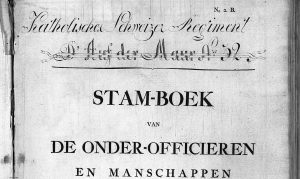
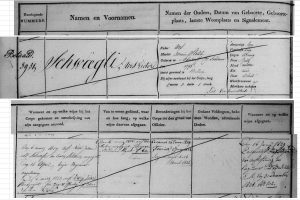
The battalions were in garrison in different places in the Netherlands, and in several occasions they moved the companies in between different cities, like, Antwerpen, Leuven, Mechelen, Breda, Bergen op Zoom, ‘s-Hertogenbosch, Dordtrecht, Gouda, Hellevoetsluis, Den Briel, Grave, Geertruidenberg, Maastricht and Gorinchem.
In June 1819 Urs Victor was corporal, and 3 years later, in June 1822 he was promoted to quartermaster-sergeant, (fourier), responsible for armament, forage, garrison and company-writer.

In 1820 General-Major Louis d’Auf der Mauer, commander of the 32nd Regiment came into problems, in March he was fired by H.M. King William I, due to the fact, that Auf der Mauer was corrupt, he recruited not only Swiss soldiers, but also fled criminals and Italian seasonal workers, ( When he recruited Italians, he noted not the birthplace in Italy, but the nearest Swiss place).
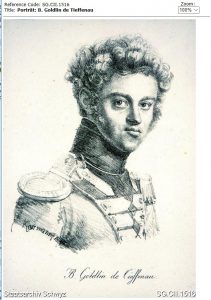
All the companies of the 32nd Regiment went to the city of Breda, and a special commission checked the antecedents of every soldier. From the 2500 soldiers, 1500 were fired and a lot of them went back to Switzerland. Urs Victor Schwägli was okee, and could stay! In May 1821 Auf der Mauer was succeeded by Lieutenant-Colonel Jean Baptiste Göldlin de Tiefenau.
In March 1823 Urs Victor signed for another two years in the army, for a pay of monthly 30 guilders. In November 1824 he was promoted to sergeant-major, and half year later, in March 1825, he signed for another four years with a pay of monthly 65 guilders.
When Urs Victor Schwägli was 37 years old he married in the city of Gorinchem with Elisabeth Maroos, (11).
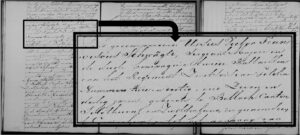
The marriage cetificate read as follows:
Ursus Victor Franciscus Schwägli, Sergeant-Major of the third Company, second Battalion of the Regiment Swiss soldiers of Goldlin, number thirty-two, old thirty-seven years, born in Bellach, Canton Solothurn in Switzerland, in garrison in Gorinchem, and having a written permission from the Commander Officer of the Regiment. Son of Ursus Schwägli, past away according the declaration of the witnesses, and of Anna Maria Stockli, without profession, living in Bellach, Canton Solothurn in Switzerland, she gave a written consent. And Elisabeth Maroos, without profession, old twenty-three years, daughter of Joseph Maroos, clerk of the cities tax-office, living in Gorinchem, here present, and giving his consent, and of Adriana van Herwaarde, past away, etc, etc.
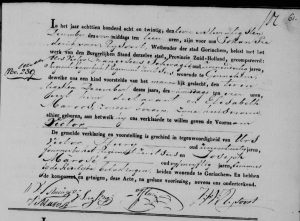
Nine months later a son was born, named “Victor” Schwägli, the next generation, (12).
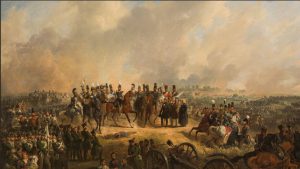
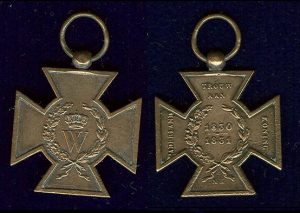
In June 1829, The Swiss regiment 32 de Goldlin was discontinued, and the soldiers had the choice to go back to Switzerland or to swop to another regiment. Urs Victor Schwägli was transferred to the 18th Infantry Division, and got in April 1831 his Bronze Medal for 12 years of loyal service in the army.
In August 1831 Urs Victor took part in the 10 days campaign with force of arms to oppress the Belgium revolt. For his participation was Urs Victor honored and decorated by King William I with the “Dutch Award of the Metal Cross 1830-1831”
In 1834 Urs Victor Schwägli was in garrison in Willemstad, I don’t think that he was living with his wive and son in the army barracks, from the museum “Mauritshuis ” in Willemstad I know that a lot of soldiers lived in small houses within the ramparts of Willemstad.
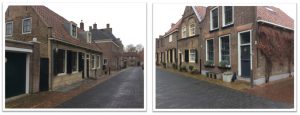
In this period a daughter was born, and got the names of her grand-parents: Maria Adriana Josephina Schwägly, (13), in the birth cerificate, we see that the civil servant wrote the last name no longer as Schwägli, but from now on Schwägly.
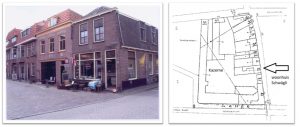
Five years later, in 1839 Urs Victor Schwägly was transferred from the 18th Infantry Division to the 2nd Regiment Infantry.
In March 1840, a part of the 2nd Regiment Infantry moved to Alkmaar, and the family Schwägly got a house just behind the army-barracks in the Doelenstraat number 372, (Kadasternumber 302).
In the six years that the family Schwägly was living in Alkmaar a son and daughter were born: Franciscus Johannes Schwägly (14), and Catharina Ursula Schwägly, (15).
In 1846 the family Schwäglij moved from Alkmaar to Rotterdam, and they lived on the “Groenendaal number 12”. Urs Victor started working as government official, controlling taxes, government contracts and regulations. His eldest son Victor started working as government clerk.
In 1847 the family of Urs Victor and Elisabeth was struck by great suffering, their daughter Catharina Ursula, old 1 year and 11 months died, (16). Seven years later, disaster struck again, when their eldest son Victor died, with an age of 25 years. In this year the family moved to the “Torenstraat” number 177 in Rotterdam, (17).
4 Years later, Urs Victor, his wive Elisabeth Maroos, and their two children Franciscus Johannes and Maria Adriana Josephina moved to the cornerhouse of the “Weste Wagenstraat” and the “Kratten-steeg”,(alley) no 692, from the city-archives of Rotterdam we know that 21 persons were living on this address .
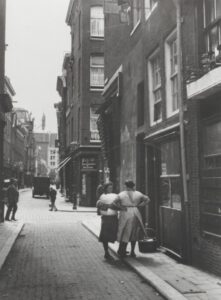
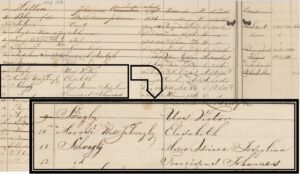
In the winter of 1858 Urs Victor Schwäglij died. This was the end of an eventful live of a Swiss soldier born in Oberdorf near Solothurn in Switzerland, who signed with the age of 28 for the Dutch Army, and served 27 years and worked another 12 years for the Dutch Government, (18).
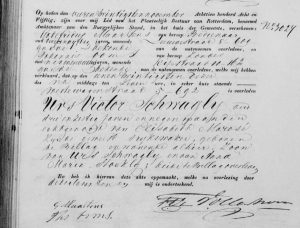
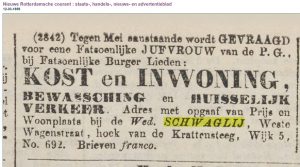
In 1859 the widow Elisabeth Schwäglij-Maroos, put an advertisement in the Rotterdammer Newspaper, in which it seemed as if she wanted to live on her own!
In 1863 her daughter Maria Adriana Josephina Schwäglij old 29 years married in Rotterdam with the 37 years old Jacobus Wilhelmus Koenen, blacksmith by profession. No childeren were born from this marriage, (19).
In 1866 we found the family in the address-books of Rotterdam, they were moved to the “Leeuwenstraat 22”: Widow Schwäglij, J.W.Koenen, M.A.J.Koenen-Schwäglij, and F.J. Schwäglij, confectioner, (Banketbakker). In 1866, Elisabeth Maroos, died, 61 years old,(20) Jacobus Wilhelmus Koenen died, 85 years in 1911, and his wife Maria Adriana Josephina Schwäglij, one year later 78 years old in 1912, (21).
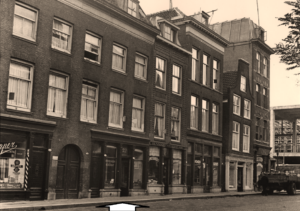
A mere accident, which I found in the register of population (bevolkingsregister) of Rotterdam, was that the youngest brother of Urs Victor; Victorinus lived a number of years with the family of the daughter, and a number of years with the son of Urs Victor, but more about this in the chapter 5 of Victorinus Schwäglij. The succession of the name Schwäglij was now, 1866, in the hands of only one man, Urs Victor’s son Franciscus Johannes Schwäglij, More from him in chapter 6: The fourth generation of Schwäglij’s with Franciscus Johannes Schwäglij.
But now the story of Urs Victor’s younger brother Victorinus Schwäglij.
Chapter 5. The life story of Victorinus Schwagli.
Victorinus, the third and youngest son of Urd Schwägli and Anna Maria Stöckli was born on in the year 1809 in Oberdorf, (22).
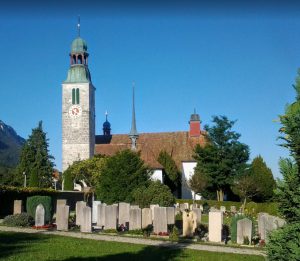
We don’t know a lot about his youth. In this period the canton Solothurn was occupied by the French, and after the fall of Napoleon in 1815, the recruitment-officer Ludwig d’auf der Mauer was in the catholic cantons to recruit soldiers for the States of Holland. And when Victorinus was 10 years old, his older brother Urs Victor left Solothurn to join the Dutch army. The training in the Dutch army was well-known over Europe, so when you wanted a career in the army, you went to Holland.
We meet Victorinus again in 1824, in the recruitment-books in the State-archive of the city of Lucerne in Switzerland, (Eintrage in den Rekrutierungs kontrollen fur die Niederlanden).
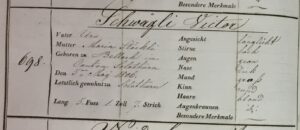
Number 698, Victor Schwägli described as: length is 159,4 cm, face oblong, forehead high, eyes grey, nose thick, mouth large, chin round and hair and eyebrows blond. Victor 15 years old signed as Swiss fusilier for 6 years for the Royal Dutch Army. They noted in the recruitmentbook: born 1806 instead of 1809, so may be you needed to be 18 years to join the army, and was Victor lying about his age, or it was another “Auf der Mauer trick”? He said goodbye to his parents, his brother and sisters and his native village Oberdorf, and went with the 28th transport, of 26 soldiers, by foot from Solothurn to the 70 km northern situated city of Bazel, and form there by boot down the river Rhine to the Netherlands, (23).


After five years, Victorinus was sure looking forward to see his older brother. I could not find out yet in which battalion of the 32nd regiment and garrison-town Victorinus was incorporated, but I am sure that the two brothers have met each other in the Netherlands. On his arrival in the garrison, Victorinus had to swear by the flag of the regiment. It usually was a festive happening, the mayor and the notabilities were invited, and on the barrack-square, the whole regiment was lined up, with in the front row the new recruits, in their new regimentals, (uniforms).
Victorinus was allowed to swear in German, and the commandant translated in to Dutch “Ik zweer onder dit vaandel trouw aan Zijne Majesteit de Koning der Nederlanden, gehoorzaamheid aan de wetten en onderwerping aan de krijgstucht”.(I swear on the flag loyalty to His Majesty the King of the Netherlands, obedience to the laws, and subjection to the military discipline), and Victorinus answered: “So help me God, Almighty”. Then there was a parade of the regiment, with support of the band of the regiment, and at the end, for everybody “Beer, bread and cheese”!
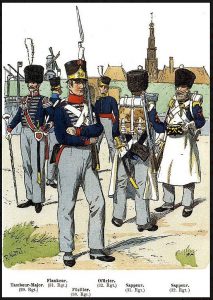
Just like his brother, Victorinus had success in the army, early 1826 he was promoted to the rank of Corporal and late 1826 to the rank of Sergeant, (24). Victorinus joined in September 1828 military manoeuvres in camp Zeist with 8000 soldiers and with visits of His Majesty the King and the Prince Fredrik of the Netherlands.
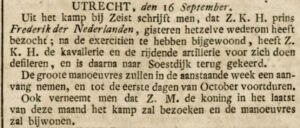
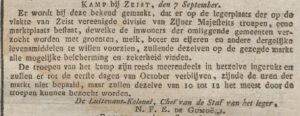
A year later, the 32nd regiment was discontinued, and Victorinus was honorably discharged after having completed his military service. The Swiss soldiers had the choice to go back to Switzerland, or signs in for another regiment, or marry a Dutch woman and start a new life in the Netherlands,(25). Two weeks after leaving the 32rd regiment, Victorinus signed for 6 years as a Sergeant for the Royal Dutch Navy. I think he went home to his mother in Solothurn, because only after four months he went on board,(26)
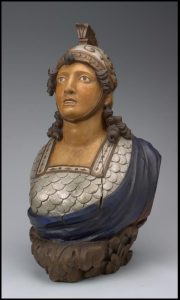
It was the month of March 1830, Victorinus went on board of the guard-ship the “H.M.Amstel” in Hellevoetsluis, this ship a floating barrack was intended for temporary accommodation and training. After 5 months on the guard-ship Victorinus had earned 154,93 guilders, but he had also some costs; for toggery 14,93, cash 21,00, for the doctor 3,87, and 2% tax 3,10.
Victorinus then went on board the corvette “Heldin”, and his pay became 28 guilders monthly. A new ship, made for protecting the Dutch settlements in the West and East Indies, (West Indies Curacao and Suriname, and East Indies the settlements in Indonesia),(27).
The ship was directly involved in the war of independence of the Southern States of Holland (Belgium), it took part in the blockade of the river Schelde and on the 27th of October 1830 in the firing of the city of Antwerp.
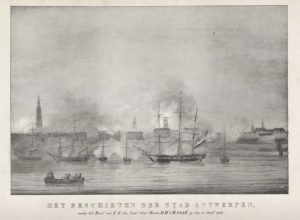
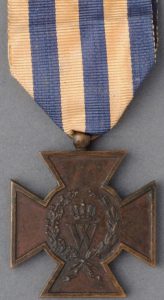
For his participation in these military operations Victorinus Schwägli was honored and decorated with the “Dutch Award of the Metal Cross” ( A four armed bronze cross with a crowned W, and a wreath of oak leaves, and on the back 1830-1831, and the words “Loyalty to King and Country”, (28).
In the daily newspaper of the “Algemeen Handelsblad” we can easily find under the ships-news (scheepstijdingen) the location of the corvette “Heldin”, with Victorinus Schwägli on board, in the international waters. In December 1830, the corvette left the port of Vlissingen to sail around the Canaries and the Azores. Via the South-English seaport-town Portsmouth it returned back in Vlissingen in March 1831.
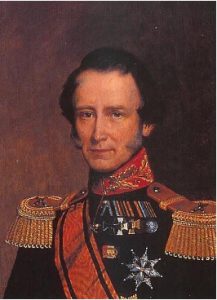
In May 1831, H.H. Prince Frederick of the Netherlands, the younger brother of King William II, came to inspect the “Heldin”.
In September 1831 the corvette Heldin went into the dock of Vlissingen, probably repairs or alterations for the journey to the East-Indies.
Finally in December 1831, left the corvette “Heldin” the port of Den Helder and sailed via Rio de Janeiro to Batavia. It was April 1832 when the corvette presents the quay of Batavia. (Due to the sea currents in the northern and southern hemispheres this was the fastest way, as of 1869 it was possible to sail via the Egyptian Suez Canal).
As of October 1831, Victorinus had already the responsibilities for the cannons, cannon-balls and gunpowder, but in August 1832 he was promoted to Gunner-major with an increase on his pay of 4 guilders monthly. He was responsible for the gunpowder room, and for filling the paper kardoezen with gunpowder for the salute shots.
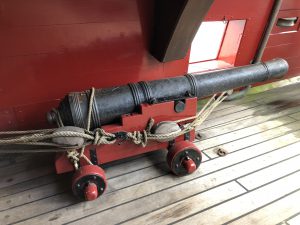
From April 1832 until Februari 1836 the corvette “Heldin” has been guarding the waters around the Dutch East Indies, (now Indonesia), and visited regularly the ports of Batavia, Soerabaja, Samarang, Padang and Makasser.
In the National Archives in ‘s-Gravenhage are the ship’s journals of the corvette “Heldin” from Commander-Captain-Lieutenant-at-sea A. Anemaet.
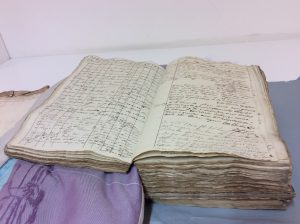
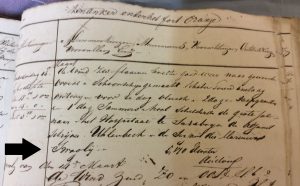
The ships-journals are a great source of information. The officers noted every 4 hours, (6 watches) , and every watch consisted out of eight bells of half an hour, so every half hour there was a bell-signal. The ships-journals of the corvette “Heldin” were as of 24-12-1831 until 10-7-1836, a total of 1660 pages, 830 sheets of paper.
On the left side they noted every watch: windzone, wind force, course, temperature, pressure, azimuth and kimpolling, location in north latitude and west longitude, and water supply at the pump. On the right side they noted all the comments, manoeuvres, operations, discoveries and events.
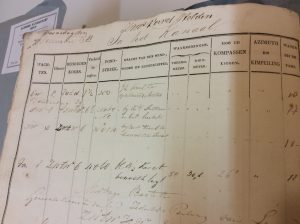
In the four hours that I spend in the National Archive, I first checked in the journals the locations of the ship compared with the news from the newspapers. The ships-journals are far more accurate, with the information out of the ships-journals you can exactly draw the route on a sea-chart. After that I have read the first five months of the journals, to get a good feeling of what happend on the ship. This was difficult, because every watch is a different handwriting.
The watch-officers thought very meanly over the lower ranks, they used words as “the poor souls” and “those youngsters”. Here a small impression of what was happening on the “Heldin”.
5-1-1832, In the pumped water, was mixed gin. Lieutenant Sluiter arrested. 6-1-1832, Let the souls cleaning, let them wash their clothes, and clean the ship. 27-1-1832, Put the corpse of Mariner “van Noort” overboard, flag and pennant half mast. 28-1-1832, Made a “Plunje-parade” (checking of clothes). 8-2-1832, Carpenter busy with repairing gunport-hole, In the Bay of Rio de Janeiro, Dutch consul on board. 22-2-1832, Set more sail, take in the bazaan. 9-3-1832, Put in irons, K.Tom and steward Hevelmeyer for taken beverage without permission.
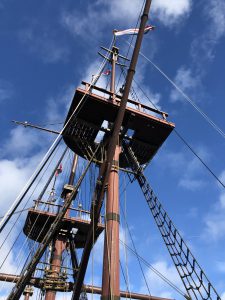 With reefing the main sail, a young boy felt out of the rigging and broke his arm. 17-3-1832, With the start of the watch, I checked the sails and the fixing of the ropes. 1-4-1832, The sailor Lafeber in the handcuffs, was drinking gin. 18-4-1832, Steering to the bay of Batavia, 13 salut shots for the commander of the Navy. 24-4-1832, In handcuffs quartermaster van Rechteren, for brutality. 7-5-1832, With cleaning the hold, noticed a rat, bread bags unusable. 13-3-1832, After setting all the sails, an extra ration gin for the equipages. 16-5-1832, During cleaning found hide with becon and vegetables, officer in arrest. 19-5-1832, Due to drunkenness in handcuffs, provost le Grand and steward Timmers. 5-8-1832, 4 men in hospital, 22-8-1832 The bootsman van Rechteren in handcuffs and punished with water and bread, for remaining ashore.
With reefing the main sail, a young boy felt out of the rigging and broke his arm. 17-3-1832, With the start of the watch, I checked the sails and the fixing of the ropes. 1-4-1832, The sailor Lafeber in the handcuffs, was drinking gin. 18-4-1832, Steering to the bay of Batavia, 13 salut shots for the commander of the Navy. 24-4-1832, In handcuffs quartermaster van Rechteren, for brutality. 7-5-1832, With cleaning the hold, noticed a rat, bread bags unusable. 13-3-1832, After setting all the sails, an extra ration gin for the equipages. 16-5-1832, During cleaning found hide with becon and vegetables, officer in arrest. 19-5-1832, Due to drunkenness in handcuffs, provost le Grand and steward Timmers. 5-8-1832, 4 men in hospital, 22-8-1832 The bootsman van Rechteren in handcuffs and punished with water and bread, for remaining ashore.
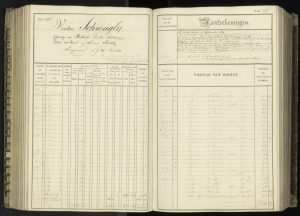
From the service-books of the Navy, with their pay-rolls, I could find out that Victorinus was in the hospital of Soerabaja from the 14th of March until the 1st of April 1833, and the doctor’s costs were 51,90 guilders, almost 2 months of salary.
After four years of patrolling they finally sailed home to the Netherlands, in February 1836 the corvette left Batavia, and after 110 day’s of sailing they were back in the Dutch port of Hellevoetsluis.
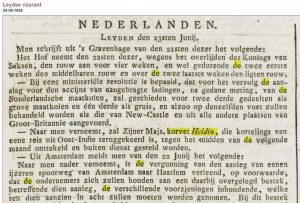
On the 10th of September Victorinus Schwägli disembarked the corvette “Heldin”. He had earned in 6 years f 2185,47 guilders, but he also made some costs: cash payed-out 632,15, toggery 10,45, tax 2% 43,71, doctor 51,90, finally paid out f 1447,26 guilders, (for comparison, a newspaper costed in 1836, 10 cents, bread 25 cents).
After a short period on the ships the corvet “Zwaluw” and the “Amphitrite”, in May 1840 Victorinus boarded on a brand new corvette the H.M. “Juno”, as of March 1841, the corvette went in active service with a crew of 120 men and 14 cannons.
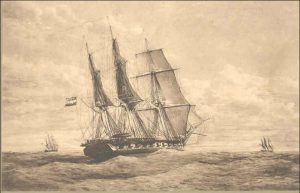
In June 1841 the “Juno” left the port of Vlissingen in a squadron with the frigate “van Rijn” and the brik “Zwaluw” for a period of 3 months sailing on the Atlantic Ocean.
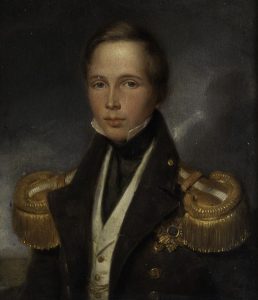
On board of the frigate “van Rijn” was the brother of King William III, Prince William Frederick Hendrik (1820-1879), who made his career with the Royal Navy. His Nickname was “Hendrik the Sailor” (Hendrik de Zeevaarder).
Early December1841, the corvette “Juno” left the port of Den Helder to retrieve in Suriname the new Director-general of the Royal Navy, Mr J.C. Rijk. A day later the “Juno” returned due to adverse wind. Two weeks later another attempt was made for the trip to Suriname. 34 days later the “Juno” reached Suriname, 3 months later they sailed back to the Netherlands with on board the new Navy Director-general and his family, At the end of May 1842 the corvette was back in Den Helder,(29). In August 1842 H.M. King William II visited the port of Den Helder and the buildings of the Royal Navy. Suddenly the King went on board the corvette “Juno”, but all was well, according the King!(30).
In October 1842 the corvette “Juno” left the port of Den Helder, as part of the squadron with the frigate “van Rijn”, the frigate “Palembang” and the brik “Zwaluw”. They went for 3 years to the West Indies to protect Curacao and Suriname, but it was not a pleasant journey, several crewmembers died on board the “Juno”:
29-11-1842 Anthony Noordhoeve, marine. 10-12-1842 Adolf van Wijk, Sailor. 05-04-1844 Nicolaas Nieman, Sailor. 01-07-1844 Jan Hendrik Aming, Master. 19-09-1844 Arie Oostwal, Sailor. 21-10-1844 Matthijs Ginjooden, Sailer (drowned). The death of Jan Hendrik Aming came in the newspapers. West-Indiën, Parimaribo 3-7-1844, The day before yesterday, there was a horrible murder committed on board H.M. corvette Juno. The suprime boatsman, an able and fine man, reprimand on that morning the cooper for breach of duty, and after his lunch, he relaxed and fell asleep.
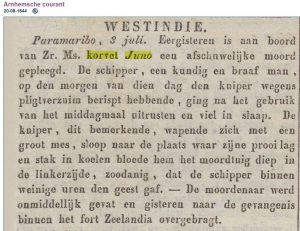
The cooper, who noted this, armed himself with a large knife, and snuck to the place where lay his prey. He put in cool blood the weapon deep in the left side, such that the fine boatsman died within a few hours. The murderer was immediately caucht, and brought over to the prison in fort Zeelandia. In August 1845 the squadron returned back in the port of Vlissingen, (31).
In June 1846 a squadron of ships left for the Mediterranean Sea. The frigate “The Prince of Oranje” with onboard H.M. Prince Hendrik of the Netherlands, the corvette “Sambre” and the corvette “Juno”. The journey went via Gibraltar, Malta, Genoa to Alexandrië, (Egypt). On their way back, in the night of 22 december 1846, the frigate “The Prince of Oranje” and the corvette “Sambre” hit each other by accident, and both ships were damaged, so they decided to sail to the Spanish port of Cadix.
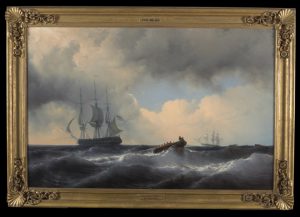
On the 28th of December the crew of the “Juno” rescued under very difficult conditions 9 persons of a sinking Spanish ship the “La Bella Antonia” 5 persons drowned during this operation. When the “Juno” sailed into the port of Cadix, they got a very warm welcome of the inhabitants of Cadix. On the 27th of January 1847 was the squadron back in Den Helder. The captain-lieutenant-on-sea W.Stort, the commander of H.M. corvette “Juno” received from H.M. the Queen of Spain, the award, Commander of the order of Charles III. Zeven crewmembers got golden and silver medals (van de Zuid-Hollandse Maatschappij voor redding van Schipbreukelingen), and five sailors got 10 guilders and a laudatory certificate.
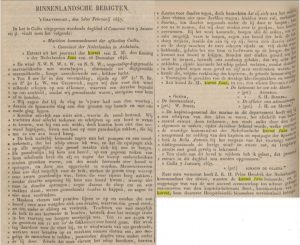
In the first half of the year 1847 the “Juno” made a journey to Batavia and Soerabaya. In the second half of the year 1847 and the year 1848 the squadron was sailing on the North Sea, it was visiting different ports of England, but mainly sailing along the coast of the Netherlands. The contact with the mainland went via a small schooner.
I think Victorinus Schwägly was very happy that they were so close to the mainland, because he had already a few years a house in Den Helder and a courtship with Miss Neeltje Spigt, also living in Den Helder .In October 1845 Neeltje Spigt gave birth to a son, who got the names: Cornelis Johannes Spigt, (32).
Two years later, in September 1847 Victorinus Schwägli married Neeltje Spigt. According to the wedding document Victorinus was still sailing on the corvette “Juno” , and the ship was in Den Helder, so he got permission from the Captain-Leuitenant-on-sea to marry Neeltje Spigt, they also noted in the wedding document that Victorinus and Neeltje acknowledge their son Cornelis Johannes Spigt, as their legitimate son. ( I don’t know how Victorinus did this, because according to the shipsjournals of the “Juno” Victorinus was in the spring of 1845 in the East Indies?) (33).
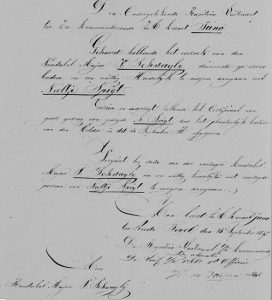
On the 1st of May 1848 their son Cornelis Johannes, 2,5 years old died in Den Helder. This was for Victorinus a moment to take a decision, he stopped sailing on the corvette “Juno” and moved with Neeltje Spigt to Hellevoetsluis, (Oosterkade 193) and Victorinus started working on the navy-ship-buildingyard as adj.officer, 1st fire-lighter, (1ste vuurwerker), responsible for cannons, guns and gunpowder.
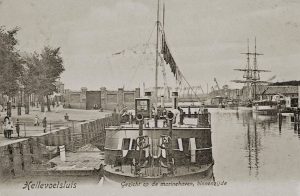
In July 1859 Victorinus Schwägli and Neeltje Spigt went to the Notary Hendrik Vlielander in Hellevoetsluis, and he made two wills, 1) Victorinus Schwägli is heir apparent for Neeltje Spigt, and 2) Neeltje Spigt is heiress for Victorinus Schwägli, (this was a half year after the death of het brother Urs Victor).
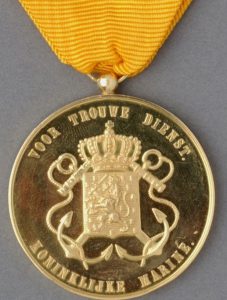
In 1864 Victorinus stopped working for the Navy, he had worked 50 years for the Navy, for those 50 years he received a golden Medal. (from 1829 untill 1864 is 35 years, of which 15 years in the tropics, which counts double makes 50 years).
In September 1866, Victorinus and Neeltje moved back to Den Helder, and Victorinus worked for a few years as insurance-agent for a funeral and provident fund.
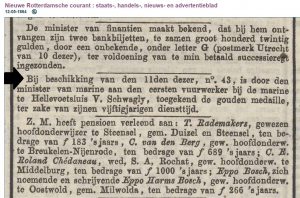
Eight years later in March 1874 Neeltje Spigt, 53 years old died in Den Helder, (34).
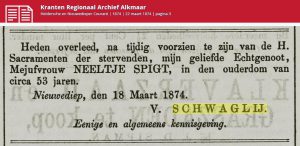
Four months later Victorinus sold all his household contents and moved in with the family of his nephew Franciscus Johannes Schwäglij at the “Binnenweg 65” in Rotterdam, (35).

Probably due to family expansion, Victorinus moved from his nephew to the family of his niece Maria Adriana Josephina Schwäglij and her husband Jacobus Wilhelmus Koenen at the “Visschersdijk 192 in Rotterdam. Four years later, the 69th years old Victorinus married with the 57th years old widow Maria Hansen, they went living at the “Noorder Markt nr 15. in Rotterdam, (36). In the coming three years the changed 5 times from address. first the moved to the “Oosterstraat 5”, from there to the “Hoogstraat 217”, from there to the “Boerensteiger 27” and as last to the “Korte Goudse Wagenstraat 6”.
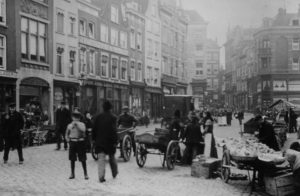
Victorinus Schwäglij died, 82 years old, in December 1891, Maria Hansen a half year later in May 1892. (37). Victorinus came with fifteen years from Solothurn in Switzerland, to follow his brother in the Netherlands, he joined 5 years the Infantry of the Royal Dutch Army, and 35 years with the Royal Dutch Navy, he sailed across the great oceans, to the East and the West Indies, and made himself heard by the saluts of the cannons. It was nice to see, that Victorinus with an age of 65 lived with the children of his brother Urs Victor. That must have been a close bond between those two brothers.
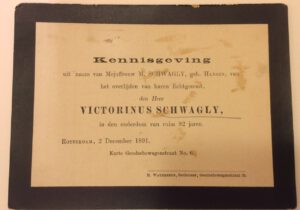
Chapter 6. The fourth generation of Schwägli’s with Franciscus Johannes Schwäglij.
Franciscus Johannes Schwäglij, the heir, junior confectioner, 25 years old, married with the 20 years old Adriana Hendrika Juliana Tas, (38).
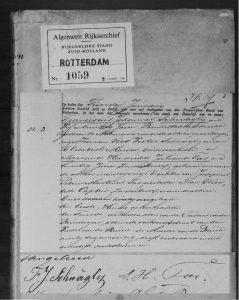
They first lived in the “Jonkerfransstraat no 13”, two years later they moved to the “Herenstraat no 18” and five years later to “t’Hang no 68” (39). Franciscus Johannes was confectioner/pastry chef and his wive Adriana H.J. Tas had a milliner’s shop. They got 6 children, but how sad, only one stayed alive! 1). Elizabeth Cecilia Adriana, born 1868, died after two years and 11 months. 2). Josephus Victor Stephanus, born 1870, died after three months. 3). Elizabeth Hendrika Maria, born 1871, she stayed alive! 4). Josephina Adriana Hendrika born 1873, died after 4 months. 5). Franciscus Victor born 1874, died after 2 months and 6). Maria Josephina, born in 1876, Twelve days after birth of Maria Josephina her mother, the 29 years, way too young, Adriana H.J. Tas died, (maternity-fever?).

Four day’s later the little baby Maria Josephina died, so Franciscus Johannes Schwagly stayed behind with his five years old daughter Elizabeth Hendrika Maria. Infant mortality in the Netherlands was very high during the 19th century, especially in the provinces of South Holland and Zeeland (up to > 300 per 1000 live births).
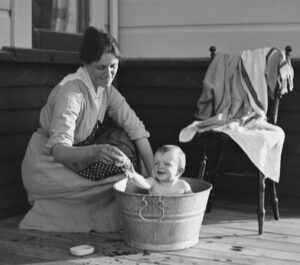
It was not common known that hygiene and health had a lot to do with each other. In 1843 Oliver Wendell Holmes wrote an article called “Contagiousness of Puerperal Fever” for the Boston Society for Medical Improvements, which would prove to be a great contribution to American medicine. It introduced a new practice that now seems obvious, but which, in Holmes’s day, was a radical new idea. Countless lives were saved, and miseries avoided, by this simple yet revolutionary suggestion: That physicians should simply wash their hands. It wasn’t until 1850 that a Hungarien doctor Ignas Semmelweis discovered that doctors should wash their hands with chlorinated water to prevent young mothers from dying of childbirth-fever shortly after giving birth, (or called childbed-fever), (41). Also around 1850 was the first pipeline built for drinking water between the dunes of Heemstede and Amsterdam, but it took another century before pure water came from the tap in all Dutch homes. And in 1882 young mothers were still advised not to wash their baby for the first six weeks.
A half year later, March 1877, Franciscus Johannes Schwägly remarried with the 30 years old widow Hendrica Theodora Stals, she had one 6 years old daughter from her first marriage named Regina Cornelia Tempel. The family lived in the “Aert van Nesstraat no 30” and two years later they shared a house with the mother and the brother of Hendrica Theodora at the “Boomgaardlaan no 50”, (42).
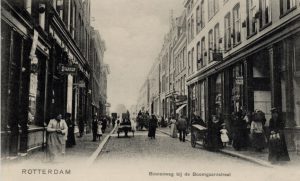
In the coming 10 years, 9 children were born, but unfortunately only 4 stayed alive!! A still-born girl in 1877, and Henrietta Josephina Maria, born in 1879. And two years later the successor was born, who took care that the name “Schwäglij” came into the next generation; Victor Franciscus, followed by twin sisters, Johanna and Maria born in 1882. Franz Joseph, born in 1884, died after three months, a year later, Franciscus was born he died after five months. Another two still-born children, a girl, in 1886, and a boy in 1887, (43).
We now arrive in the year 1890, and the “Schwäglij-clan” in Rotterdam consist out of 12 members: Victorinus Schwäglij, 81 years old, and his wive Maria-Schwäglij-Hansen, 69 years old. Jacobus Wilhelmus Koenen, 64 years old, and his wive Maria Adriana Josephina Koenen-Schwäglij, 56 years old, and her younger brother, Franciscus Johannes Schwäglij, 47 years old, and his wive Hendrica Theodora Schwäglij-Stals, 43 years old, and their children, A) Regina Cornelia Tempel, 19 years, B) Elizabeth Hendrika Maria Schwäglij, 19 years, C) Henrietta Josephina Schwäglij, 11 years, D) Victor Franciscus Schwäglij, 9 years, and the twin-sisters E) and F) Johanna and Maria Schwäglij, 7 years old.
The family Schwäglij-Stals changed from address in the nineties more than 10 times. In the addressbooks of Rotterdam we also find the professions of father Franciscus Johannes Schwäglij, confectioner, baker, baker’s trade, and from 1894 until 1897 he had a “Zeeuws Mosselhuis” (Zeelands Musselhouse) on the “Schiedamschedijk 117”.
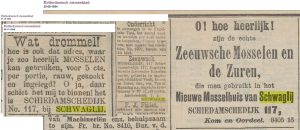
Franciscus Johannes Schwäglij and his wive Hendrica Theodora Stals had to work hard to support their household, they experienced difficult times, but also beautiful times when their children got married and when grandchildren were born, and when children were successful in the Netherlands, in the Dutch East Indies and in Amerika, (see Chapter 8).
Franciscus Johannes Schwäglij died, 77 years old in 1920,(44). His wive Hendrica Theodora Stals went with an age of 77 years with her son on the passenger ship the “New Amsterdam” to visit her family in America.
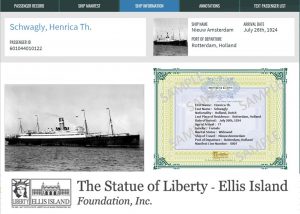
Hendrica Theodora Stals died with an age of 89 years in 1936,(45).
Chapter 7. The fifth generation of Schwäglij’s, and the children of Franciscus Johannes Schwäglij.
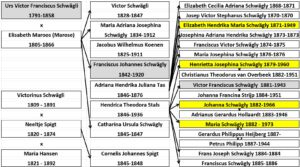
A) Regina Cornelia Tempel, the daughter out of the first marriage of Hendrica Theodora Stals, got married 25 years old, in 1896 with Francis Louis Zack, merchant in colonial groceries. they got 5 children. Francis Louis died in 1930, Regina Cornelia in 1938, (46).
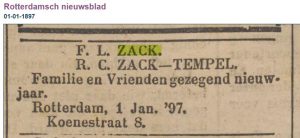
B) Elizabeth Hendrika Maria Schwäglij and her sister C) Henrietta Josephina Maria Schwäglij and Theodora Johanna Burgers opened together in 1904 a fashion house on the “Zeevischmarkt no 7” in Rotterdam.
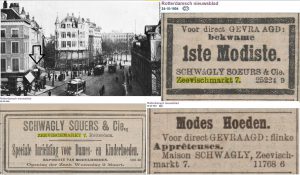
Note, in the above advertisements, the name Schwägly was written with an “y” instead of “ij”.
Henrietta Josephina Maria Schwäglij had already some experience in the fashion branch, she worked more than a year (nov. 1899 until febr. 1901) in Amsterdam in a women’s fashion store in the street “Reguliersbreestraat” with the name ” de Nederlandsche Mode Maatschappij” of the men G.H. Bokeloh and F.J.H. Determeyer, ( they had a number of shops in Amsterdam, for women’s fashion, men’s and children’s clothing, and uniforms and corporate clothing with their own workshops).
In 1905 Henrietta J. Schwäglij married with Christianus Theodorus van Overbeek, and he was also registrated as commercial traveller on the “Zeevischmarkt no 7”, (more about him in chapter 8),(47). Two years later in 1907 Theodora Johanna Burgers married with Gerhard Volkers, a tailor who lived just around the corner at the “Visschersdijk no 97”. In 1908 the fashion boutique moved to the “Ammanstraat no 2” on the corner of the “Diergaardelaan”, and was registrated on the name of Elizabeth H. M. Schwägly. In the addressbook of Rotterdam from the year 1908, we saw that on the same address were living Henrietta J. Schwägly and Christianus Theodorus van Overbeek.

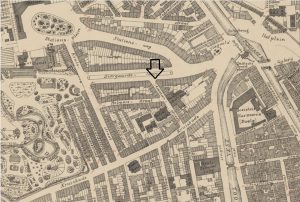
In August 1908 the fashion Boutique Maison Schwägly went bankrupt, the curator collected all the claims, and planned a meeting with the creditors, and when the notice of dividend was ready, the bankruptcy was abolished, (January 1909). Was the business to difficult or wanted one of the ladies to stop with the fashion boutique, I could not find the reason for the bankruptcy.
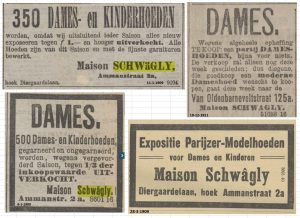
In 1909 the fashion boutique moved to the “Oldenbarneveltstraat 125a”, and a year later Elizabeth H.M. Schwägly went to Germany, and Henrietta J. Schwägly was running the boutique, (48). In 1911, when Elizabeth came back from Germany, the two sisters made new plans. Was it the threat for the “First World War”, or was the marriage from Henrietta with Christianus van Overbeek a big failure? Anyway there was a winding-up sale of “Maison Schwägly” and Henrietta J. Schwägly divorced from Christianus van Overbeek.
Henrietta J. Schwägly emigrated to America, together with two cousins, Emma Stals and Antonia de Jong, they left Rotterdam on the 5th of October 1912 with the passenger ship the “SS Rotterdam” to the father of Emma Stals, Jacob Stals, who lived in New Jersey in America.
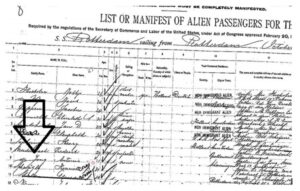
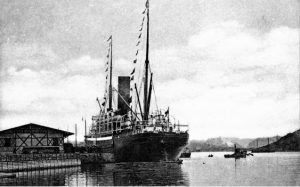
Two years later Elizabeth H.M. Schwägly (sister Bessie) emigrated to America. (49).
On the 28th of July the “First World War” started, and in November 1914 the Britisch Government declared the “Noordzee” as a warzone, Every ship was controlled in an English harbour before they could travel through the “Noorzee”, and they got instructions where the naval mines were located.
In July 1918, both sisters Schwägly came in the newspapers, in the New York Tribune and the New York Sun, (50).
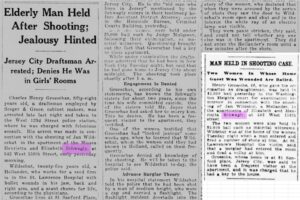
Elderly Man Held After Shooting; Jealousy Hinted. Jersey City Draftsman Arrested; Denies He was in Girls’ Rooms.

Charles Henry Groeschae, fifty-eight years old, a draftsman employed by Seeger & Gross, cabinet makers, was arrested late last night and taken to the West 123d Street police station, where he was charged with felonious assault. His arrest was made in connection with the shooting of Jan Wildschut in the apartment of the Misses Henrietta and Elisabeth Schwagly, at 542 West 159th Street, early yesterday morning. Wildschut, twenty-five years old, a Hollander, who works for a seed firm is in the St.Lawrence Hospital with bullit wounds in his jaw, back and right arm, and a scant chance for live, according to the physicians. Groeschae ilves at 81 Sanford Place, Jersey City. He is the “old man who lives in Jersey” mentioned by the Schwagly sisters in their testimony before Assistant District Attorney Joyce in the Homicide Bureau, Criminal Courts Building, yesterday. Both the woman were held under $5,000 bail each by Judge Mulqeeen, following their examination, as material witnesses. Questioning brought out the fact that Groeschae had a key to their apartment. While under examination the draftsman admitted that he had been in New York City Tuesday night, but said that he had gone home to Jersey City about midnight. The shooting took place shortly after 1.a.m.
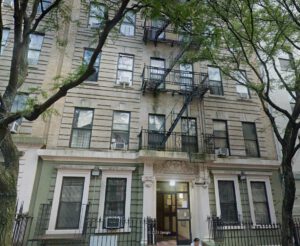
Engagement Is Denied. Groeschae, according to his own statements, has known the Schwagly sisters for about two years, since the time his wife committed suicide. One of the sisters told Mr. Joyce that Groeschae had asked her to marry him. This he denies. He has been a frequent visitor to the apartment, they testified. One of the woman testified that Groeschae had “looked jealous” some weeks ago, when he learned that Wildschut, whom the woman said they had known in Holland, called on them frequently. Groeschae denied all knowledge of the shooting. He will be taken to the hospital to see Wildschut today, the police said.
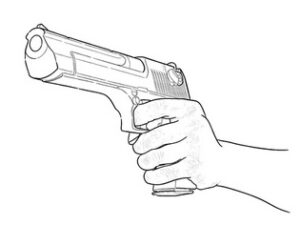
Advance Burglar Theory. In his hospital statement Wildschut told the police that he had been shot by a man of medium height, who wore a cap and carried a flashight. The flashlight incident dovetails into the story of the woman, who declared that when they were aroused by the series of shots they saw the door to Wildschut’s room open and shut and in the interum the white ray of an electric lamp was visible. They were panic stricken, they said, and could not tell whether any one else was in the apartment. They did not enter the Hollander’s room until a few minutes after the shots.
VICTIM OF SHOOTING DIES. Homicide Charge Against Man in Wildschut Case.
Ja. D. Wildschut, the Hollander who was shot Wednesday morning in the apartment of Henrietta and Elizabeth Schwagley, died in St.Lawrence Hospital at 6 o’clock last night. The charge against Charles Henry Groesche of 81 Sanford place, Jersey City, who was arrested and charged with felonious assault relative to the case, accordingly was changed to homicide. Wildschut, who was 25 years old, was a travelling salesman. He was shot by an unindentified man. The police allege that Groesche had a key to the apartment.
So far the newspaper reports of the shooting at the misses Schwägly’s apartment, I just need to find out what punishment the murderer got!
Ten years later in May 1928 both sisters came back to Holland, and Elizabeth H.M. Schwägly was registrated as boarding-house keepster. As of 1938 they lived together in voorburg (Den Haag). Elizabeth H.M. Schwägly died 77 years old in 1949, Henrietta Josephina Schwägly died 81 years old in 1960, (51).
Chapter 8. Mr Carter and Miss Corrina.
In 1905 Henrietta Josephina Schwägly was married to Christianus Theodorus van Overbeek, and he was a very exceptional man, may be was this one of the reasons why Henrietta Josephina’s marriage lasted only for 6 years, she divorced him in 1911, (52).
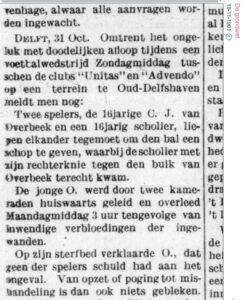
But who was Christianus Theodorus van Overbeek? He was the third child in a family of 13 children, in which one brother Daniel Cornelis died only one year old, and another brother, Cornelis Johannes, two years younger as Christianus, died at an age of 16, after a hard collision on the football field, (see newspaper article on the left).
The father of Christianus, Hendricus van Overbeek, was a merchant by trade, and first married with Elisabeth van der Poel, they got two children, but shortly afterwards Elisabeth died. A year later Hendricus remarried with Engelina Frederika van Lieshout. She gave birth to eleven children between her 30th and 45th years of life. Christianus father, Hendricus past away in 1911, he wouldn’t experience all his son’s great successes, (53).
Christianus was a sporting man, he won prices with cycling, athletics and as a sharpshooter of the “Rotterdamsche Shootingclub”.
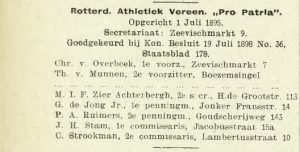
In 1908, Christianus was only twenty-six years old, he became the 1st president of the best known Athletic Association of Rotterdam “Pro Patria”.
When I was searching through the registers of population of Rotterdam, I found a stricking note, on one of the register cards of Christianus T. van Overbeek, there was noted: named himself Mr.Carter (Mr Carter and Miss Corrina). See also the stamp on top “Vuurwapen” he owned several firearms!”
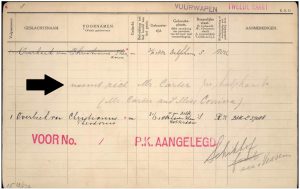
When I entered this name in the database of the Dutch newspapers, (Delpherkranten.nl), I got more than 250 hits with a wealth of information.
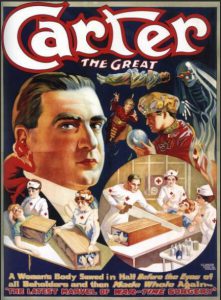
Around 1900 there was a magician and illusionist in America, John Harris, who called himself “Carter the Great” and he was married with a Corinna Carter. He travelled around the world, made seven worldtours to Australia, New Zealand, India, China, Sri Lanka , Egypt and Italy with a great company of people and a lot of scenery and heavy equipment of approx 30 tons. This equipment probably saved his life and that of his employees, due to the weight of all this equipment, he got in 1912 no tickets and permission to travel back to America with the “RMS TITANIC”. The owner of the “RMS TITANIC” the Brittisch shipping company, White Star Line, wanted that the ship would became the fastest passenger ship then in service.
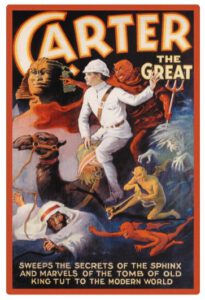
Christianus T. van Overbeek, had plans to imitate this Mister Carter, according to what I found in the newspapers, he even went to America to see and learn from this Mr.Carter. But his wive Henrietta Josephina Schwägly may be did not like his plans at all, and was that the reason for divorce? Did she not like to play his assistant on the stage, and to be a target in one of his shooting acts?
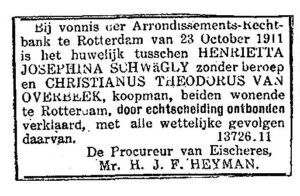
A more credible reason was that Christianus had an affair with another woman, and may be the woman who dared to play his assistant, the variety- artist Christina Vreezen? In 1913 they both were registered on the adres: Oldenbarneveldstraat nr 73A in Rotterdam.
In the divorce document is on request of Henrietta Josephina Schwägly, the judgment of the district court of Rotterdam, with the reason that the marriage was dissolved by divorce, on basis of “adultery committed” by Christianus Theodorus van Overbeek, and no objection has been lodged against the above mentioned judgment.
Christianus T. van Overbeek carried on and started with performances as of January 1913. A year later Christina Vreezen joined him, and then performing as “Mr Carter and Miss Corrina”. (note: Mr Carters wife in America was called ” Miss Corinna” with dubble n, Christianus called his lady-help “Miss Corrina” with dubble r.
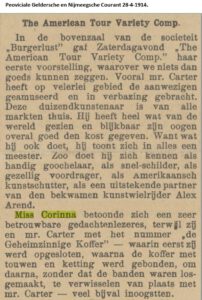
The first two years, you could read critical articles in the newspapers, that tricks failed, due to a small platform, but after those two years, only praising articles with admiration and respect for “Mr.Carter and Miss Corrina”. Often they performed for Catholic associations and institutions, and money was collected for a good cause, or they performed selflessly for a hall full of unemployed, But after performing at markets and funfairs they soon performed in theaters and cinemas. They than stayed in a larger city for ten or fourteen days, billboards would be posted in the city, the local press was invited, and advertisements would appear in the local newspapers. There were afternoon matinees for the children, and evening performances for the elderly. Performances lasted more than three hours.
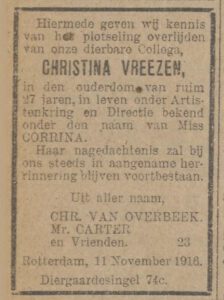
In November 1916 suddenly his assistant, only 27 years old, Christina Stijntje Vreezen died in the Diaconessen-hospital on the Westersingel, (54).
It was quiet for a while with performences, but in March 1919 Christianus T. van Overbeek already performed again with a new “Miss Corrina”, the 21 years old miss Johanna Flaes. I also found on her register card from the registers of population of Rotterdam noted: named herself “Miss Corrina” plays together with Mr. Carter, see Van Overbeek! (55).
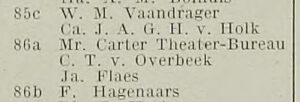
From 1926 she lived with Christianus together first at the Kruiskade 82, and from 1931 at the Diergaardesingel 86. In the old adressbooks of Rotterdam, there was noted behind Christianus name: artist, party arranger and theater agency.
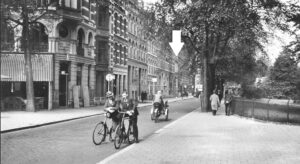
When in 1925 “Mr. Carter the Great” in America celebrated his 25-years of artist-existence, Christianus van Overbeek celebrated this as well in the Netherlands, although he only existed for 12 years, just to get some extra publicity!
In 1928 the mother of Christianus, Engelina Frederika van Overbeek, born van Lieshout past away. And in this period Mr.Carter and Miss Corrina started with a programme on the radio, called Musical novelties and humoristic.

They performed for various royal houses and received awards from H.M. the Queen, from the Sultan of Turkey, from the Shah of Persia, from the ex-Crown Prince of Germany and from the King of Belgium. In 1943 and 1944 during the Second World War he had almost daily shows to collect money for the Dutch soldiers (Frontzorg) who were fighting with the Germans in warzones, so rather controversial! At the end of his carrier he did only shows for children parties.
Here an overview of all his different acts, which he all gave different names: Christianus started with the “SECRET CABINET”. Mister Carter went into a bag that was sealed, the bag was put in a cabinet and covered with a black cloth, and after a minute Miss Corrina appeared out of the cabinet.
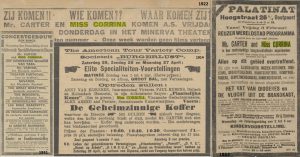
He adjusted this act every few years, so it became the “SECRET SUITCASE”, then the “SECRET BEERBARREL”, then the “BLACK CABINET” and at last the “ESCAPE FROM THE SAFE”. Mr Carter went into the safe, and spectators were allowed to secure the safe with ropes and and chains for 8 minutes. And then was the safe covered with a black cloth by Miss Corrina. And at that moment, Mr Carter appeared in the back of the theater, while Miss Corrina at the same time disappeared from the stage. Mr. Carter walked across the hall to the stage, took the cloth, ropes and chains away from the safe, and Miss Corrina appeared out of the safe !!
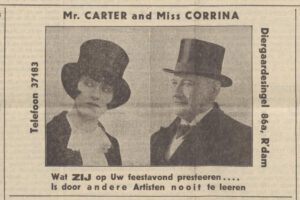
Mr. Carter was juggling with heavy weights which he catched with his shoulders, this act was called, “BUFFALO BILL, THE KING OF STEEL”. Another trick of Mr. Carter was to let Miss Corrina float on the top of a sword. He had several magic and dressage acts with ducks, pigeons and dogs. He was a virtuoso, sang songs, could draw very fast and he mastered Japanese juggling.
Christianus could ride a bicylcle, and while riding dissamble the bike, so at the end he was riding on only one wheel. He could ventrilo-quize (buikspreken) with dolls with the names of “THE WONDER OF TAZA” and “THE WONDER OF MEWI”. He imitated a lot of well known persons like, The Emperor Frans Josef, Hitler, King George, King William III, Prince Hendrik, Mussolini, the French President Poincaré and the serial killer Landru.
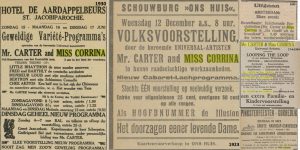
Mr Carter was a compere, a sharpshooter, riding on one wheel, he fired with winchester guns, bullits on a targetdisc on top of Miss Corrina’s head. He was adept at shooting, he fired between his legs, with his back to the target, in the back of the room, via a mirror with two rifles upside down on his shoulders, at two targets with both hands. He raised and carried a big barrel in which Miss Corrina made loopings on a bike, this act was called, “LOOPING THE LOOP”.

He let a motorcar with four persons inside driving all over himself, and he did the well known trick of sawing Miss Corrina in two.
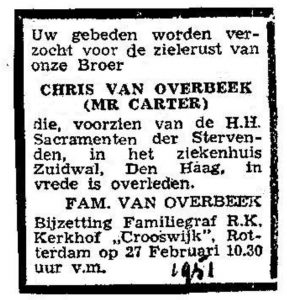
Mr. Carter’s acts were interspersed with acts by Miss Corrina, she was a clairvoyant, could read thoughts, which amazed the audience, by mentioning names of people in the audience, and tell what these people had in their bag or coat pockets, or didn’t have and then return the item in question. She did dance numbers, and cycled through a burning death-circle. The acts followed each other quickly, so the attention of the spectators remained focused throughout the evening on Mr Carter and Miss Corrina, an evening-filling program of more than three hours. Christianus Theodorus van Overbeek died in 1951, (56).
We carry-on with the fifth generation of Schwäglij’s, the children of Franciscus Johannes Schwäglij
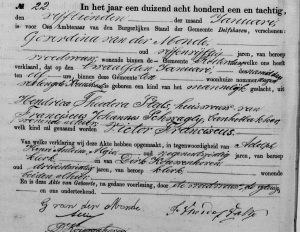
We started in Chapter 7 with the fifth generation of Schwägly’s and with the children of Franciscus Johannes Schwäglij .
A) Regina Cornelia Tempel, B) Elizabeth Hendrika Maria Schwäglij and C) Henriette Jospehina Schwäglij. We now move on to the fourth child, D) Victor Franciscus, he was born in Delfshaven, in 1881, with 13 years, he started working on a ship in Amsterdam, and later on a hotelship in Hellevoetsluis, (57).
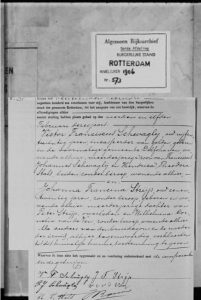
In 1897 he came back to Rotterdam, and started as beerdealer, later collector of money, and as of 1907 first as steward and later as master-clerk at the H.A.L. (hofmeester-bediende bij de Holland Amerika Lijn). He married in 1906 in Rotterdam with Johanna Francina Strijp, (58).
Here an overview of the children from this marriage, the sixth generation of Schwäglij’s.
Hendrica Theodora Schwäglij, (Jet) born Rotterdam in 1907, (59). Wilhelmina Cornelia Schwäglij, born Rotterdam in 1908 and died six months later, (60). Elizabeth Wilhelmina Schwäglij, born Rotterdam in1909, and died 2,5 monhts later, (61). Between september 1911 and june 1912, the family lived in Amsterdam at three different addresses, (Beverstraat-Balistraat en Javastraat), what the reason was for moving for a half year to Amsterdam is me not clear ? May be father Victor Franciscus found work in Amsterdam.

In this period Franciscus Johannes Petrus Schwäglij, (Frans) was born on the 16th of November 1911, (62). Back in Rotterdam, Johanna Francina Schwäglij, (Jopie) was born in 1913, and Maria Regina Schwäglij, (Riet) five years later1918, (63). Another four years later Francina Maria Gerardina Schwäglij, (Franca) was born 1922, (64). More about these children in chapter 9, the sixt generation of Schwäglij’s.
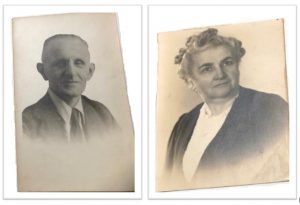
The family of Victor Franciscus Schwäglij and Johanna Francina Strijp changed a number of times from address, between 1930 and 1940 they moved almost every year: Tulpstraat13, Nassaukade 82, Cornelis Trompstraat 10, Oeverstraat 24, Strevelsweg 72 and 119, Pretorialaan 83, Dordtselaan 115 and 44, Randweg 85, Hillevliet 23, Pleinweg 109 and 66.
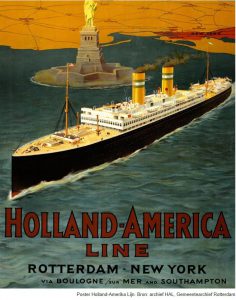
Victor Franciscus Schwägly was working on different ships of the Holland America Line, in 1923 on the “S.S.Veendam”, in 1924 on the “S.S.Nieuw Amsterdam” and in 1934 on the “S.S.Rotterdam” in the passengers-lists of Ellis-Island in New York, I found him 14 times, he had worked more than 35 years for the HAL.
During the “Second World War” America and England had confiscated ships in order to transport soldiers. The “S.S.Nieuw Amsterdam” transported 350.000 soldiers in the Pacific Ocean. During the bombardment of Rotterdam in May 1940, the SS Statendam went on fire and was totally destroyed.
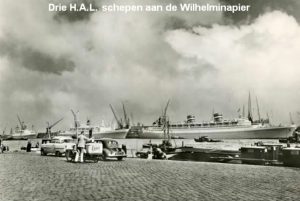
Victor Franciscus Schwägly landed in Australiä, and it was due to the war not possible for him to go back to Holland, he got homesick for his family, his wife and his children. Victor Franciscus Schwäglij past away on the 24th July 1943, and is buried on the Botany Cemetery in Sidney Australiä.
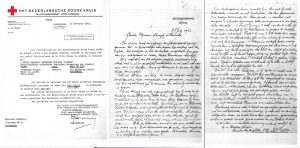
Bernard van de Walle, the priest from the St.Mary’s Cathedral of Sydney, who visited Victor Franciscus regular in the last few months of his life wrote the following letter for the family in Holland.
St.Mary’s Cathedral Sydney. 28 July 1943.
Dear Mrs Schwagly and Family.
A sad task rests upon me, as it is my duty to tell you about the illness, the death and the funeral of your husband and father, Victor Franciscus Schwagly. When I am writing this letter, a horrible war is still going on, and we don’t know, if you will receive this letter but we entrust him to God. This letter will open the wound again, the wound of the loss of your husband and father, but this letter will also afford you some consolation, to hear how peacefully he died.
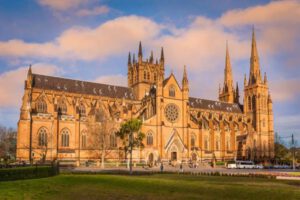
Mr. Schwagly was sick, incurable sick when he came under medical treatment of a Dutch docter. In Melbourne he was in the hospital, and from there he came to Sydney. Here he had for some time a room in a hotel. They told me, when I was in the cathedral that he wanted to speak to a Dutch priest. This was a few months before he died. From that time on, I visited him regularly. And during these visits he was telling me, about you all, with a lot of love and kindness, and showed me your pictures. I know Rotterdam, I was there six weeks before I went for my mission to the Salomon Islands, so I could talk with him about Rotterdam, and I tried to decrease his sorrow.
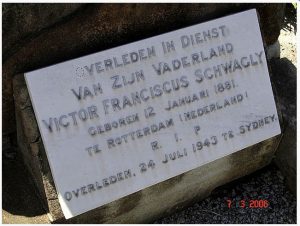
His irreproachable life made him beloved by a lot of Dutch people and also Australians, who visited him during his sickness. They gave him some sunshine during the last days of his life. At the time, that he still was in the hotel, the called for me, and I gave him the last sacraments. Later they brought him to the R.K.Hospital, where he was for several weeks, and he received twice a week the H.Communion. Everybody was really good and friendly towards him, and he had the best treatment, even so he was in heavy pain, he always smiled when I came. And I have to tell you, he learned me how to pray. He always prayed the rosary. Really he had a blessed and peaceful death but his mind was always with you, and I did understand that he really missed you all. On the 24th July 1943, Saterday he passed away calmly. On the 27th July 1943, Tuesday at 10 o’clock, I celebrated the H.Mass in the Cathedral of St.Mary, and from there we brought him to his last resting-place, with all the Dutch and Australian friends.
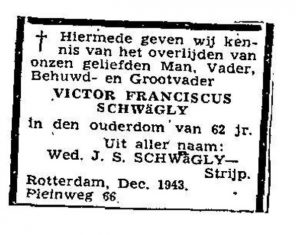
At the graveside, I did the normal prayers, the K.P.M. gave some money to celebrate some masses in his remembrance, and also an Australian lady, who took care of him. How sad, the news of his death, must be for you all, but it must give some comfort to know, that your husband and father died peacefully, and strengthened with the sacraments. My sincere condolence, By the grace of God, Bernard van de Walle, S.M. R.K. Priest Missionaire of the South Salomons Islands, (65).
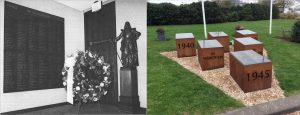
After the Second World War, a memorial plaque came in the head office of the Holland America Line in Rotterdam, with the names of 264 employees who died during the WW2, including Victor Franciscus Schwagly, when in 1972 the head office moved to Stamford in the United States the memorial plaque moved also to the U.S.
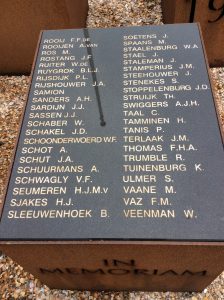
In 1989, the Holland America Line was purchased by Carnival Corp, thus becoming an American owned cruiseline with headquartered in Seattle in the United States. In 2010 a new monument was revealed on the “Kop van zuid” near the location of the S.S. Rotterdam.
Johanna Francina Strijp died in 1951 in Rotterdam, (66). After the live of Victor Franciscus Schwäglij, we end in this chapter with his two younger sisters the twins Johanna and Maria Schwäglij.
E) Johanna Schwäglij was born Rotterdam in 1882 and married 25 years old in 1907 in Rotterdam with the 24 years old Adrianus Gerardus Hollaardt, an office worker, and later confidential clerck. Four children were born out of this marriage, Maria Elizabeth Henrietta, Franciscus Adrianus, Johanna Adriana and Adrianus Gerardus Hollaardt. Father Adrianus Gerardus Hollaardt died in Rotterdam in 1946 and Johanna Schwägly died, old 73 years in Den Haag in 1956, (67).
F) Maria Schwäglij, born in Rotterdam in 1882, and married in 1912 at the age of thirty with the twenty-four years-old Gerardus Philippus Heijberg, born Rotterdam in 1887. Since Maria was already five months pregnant, they left the Netherlands two days after they had married for Batavia in the Dutch East-Indies . Four months later they had a stillborn child, (68).
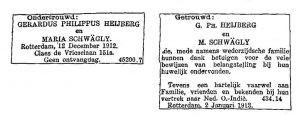
A year later in 1914 a daughter was born, named Hendrica Johanna Maria (Henny) Heijberg, (69).
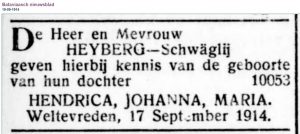
Gerardus Heyberg was in Batavia working for the Post, Telegraph and Telephone Service. At first Maria was enjoying life. The colonists in the Dutch East Indies lived lavishly in large households with many Indonesian servants. The wives had unlimited leisure whilst amahs look after their children and the cooks, gardeners, housemaids and ‘boys’ took care of the household chores. They played Mah-jong at the club and sit drinking cocktails by the pool. They visited their hairdressers and manicurists and discuss the latest European fashions. They travelled to and from their homeland in luxurious ocean liners.
However, Maria and Gerardus did not had a happy marriage, Maria learned that Gerardus was an unfaitful husband and he infected her with syphilis. Maria Schwäglij divorced from Gerardus Philippus Heijberg, in Batavia in 1920 (70), and the court awards the custody of Henny (then five-years-old) to her father which was custom at that time. Maria was forced to take her little daughter to the Netherlands in December 1920 to live with Gerardus‘ brother August Heijberg and his wive Elisabeth Jansje Overgaauw in The Hague, (71). In June 1921 Maria Schwäglij married in Rotterdam with Petrus (Petrie) Philipp, ships-captain with KPM (Koninklijke Pakketvaart Maatschappij) and living in Singapore. In september 1921 Maria Schwäglij travelled to Singapore, (72).
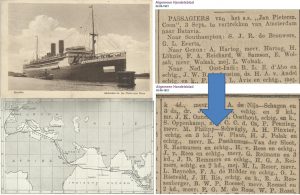
After three years Maria Schwäglij moved to Hong Kong and after another three years to Bangkok in Thailand. She was still in good contact with her daughter Henny, and when she heard that the foster parents August Heijberg and Elisabeth Overgaauw had sent Henny to a boarding school, Maria Schwäglij went to the Netherlands and took (kidnapped) her 15 years old daughter Henny and travelled to Captain Philipp in Bangkok, (73). In Bangkok they had a privileged existence, living in a large house with servants, enjoying a lively social scene. In Thailand (then Siam) Europeans were treated as an elite class, and live is extremely pleasant for the next twenty years. Hendrica Johanna Maria, Henny married a Scottisch businessman John Arthur and in 1937 a son is born with the name of Alan. This quiet live ended with the advent of the World War 2, and they were interned by the Siamese Government.
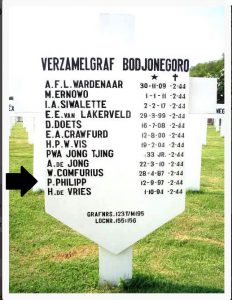
In Februari 1944, during the Second World War, Petrus (Petri) Philipp was killed by Japanese military police, the “Kempeitai”, decapitated with a samurai-sword in the place Bodjonegoro on the island Java in Indonesië. He refused to sail ships for the Japanese. He was buried on the Dutch Cemetery Ancol in Jakarta. Here are buried a total of 1270 victims of the Japanese domination.
After World War 2, and after more than 25 years, Maria Schwägly came back to the Netherlands, to live with her sister Henrietta Josephina Schwägly in Rotterdam. Maria Schwägly was called by her Dutch nieces and nephews “Aunt Miep”, and they remembered her “as a fun lady and very original”.
Henny-, John– and Alan Arthur migrated to New Zealand and in the late 1960’s Maria joined them in Auckland. then in her eighties, she is “Oma” to Alan and his family and she enjoyed family life. As she becomes frailer, she was taken care by her daughter Henny, until dementia made it necessary for her to move to a nursing home. There in 1973 Maria died at the age of ninety and after a Requiem Mass, she was buried in Auckland’s Mangere Lawn Cemetery
Chapter 9. The sixth generation of Schwägly’s
Victor Franciscus Schwägly and Johanna Francina Strijp had 6 daughters and one son, two daughters died within 6 months. Here an overview:
1). Hendrika Theadora Schwägly (Jet), the eldest daughter, was born in Rotterdam the 23rd of February 1907, she became engaged to Piet Buskens on the 10th of March 1929, Piet (Petrus Maria) Buskens was born the 22nd of January 1906 in Utrecht, and of profession hydraulic engineer.
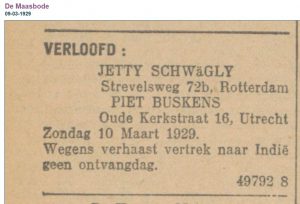
According to the newspaper “De Maasbode” they engaged due to departure hurries of Piet Buskens to Indië. I found Piet Buskens on the passenger list of the Motorship “Fulda”, that departed from Singapore on the 26th of April 1929 and arrived in Tanjung-Priok, the harbour of Jakarta on the 2nd of May 1929, his adress was Goenoengsahari 60 in Bandung.
Hendrika Theadora Schwägly, 23 years old, married on the 1st of October 1930 in Rotterdam with Piet Buskens, but Piet was in Indië, so she married by proxi, (met de handschoen), and the authorised representative was her father, Victor Franciscus Schwägly. On the same day Hendrika Theadora Buskens-Schwägly left for Indië.
It must have been an emotional day for her, to marry the man you love, who is more than 11.000 km far away from you, and then say goodbye to your parents, brother and sisters and leaving the Netherlands behind you to go to the unknown Netherlands-Indië.
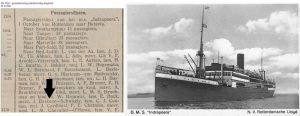
I found her name on the passenger list of the “MS Indrapoera”, the ship sailed from Rotterdam to Southamton, via Tanger, Gibraltar, Marseille and Port-Said and arrived on the 1st of November 1930 in the Dutch-Indies.
From this marriage were born one son and one daughter. But 10 years later on the 19th of December 1941, Hendrika Theadora Schwägly, 34 years old, remarried in Batavia with the 42 years old Willem (Wim) Meuleman. Wim was born in Amsterdam on the 26th of April 1899, son of Gradus Meuleman and Hendrika Suiker, and was working in Ned.Indië for the “Holland Colombo Trading Society LTD” which was based in Djakarta-Kota, and was exporting tea, coffee and rubber.
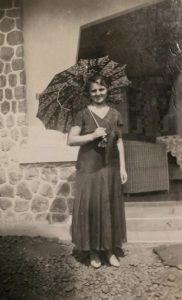
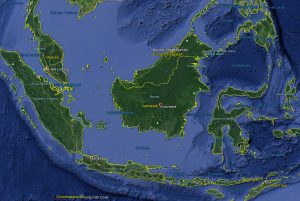
The war in the Pacific began December 7, 1941, when the Japanese bombed the US naval base Pearl Harbor in Hawaii.
On the night of 10th to 11th of January 1942 Japanese troops occupied the islands Menado and Celebes, and on the 1st of March Japanese troops landed on four places on the island Java. Seven days later the Allied forces in the Dutch East Indies surrendered.
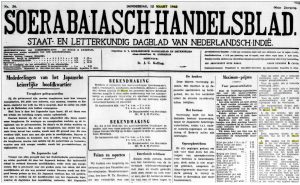
European citizens including Wim and Jet were sent to Japanese camps in Indonesia, men separated from women and children. Indonesian rebels killed small groups of Europeans, especially the Dutch, and larger groups were betrayed to the Japanese.
The military detention camps had a death rate of more than 25%, there was hardly any food in the camps, and the Japanese behaved very cruel to the prisoners, and caning was the least that could happen. 30.000 European citizens died in these camps. The detention period lasted more than three years, it must have been a hard time for Wim and Jet.
The Japanese occupation ended with the capitulation of Japan in August 1945. Two days later called the leader of the national movement to independence from the Netherlands, Sukarno, the independence of Indonesia, and on the 18th of August 1945, was Sukarno appointed as first President of Indonesia, and Muhammed Hatta to Vice-President.
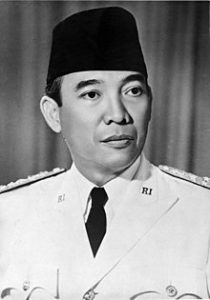
The liberation of the Dutch people in the Japanese camps went slowly. Sukarno, who had many Japanese contacts, convinced his countrymen that these prisoners were still a danger for the Indonesian freedom movement. Partly because the prisoners formed political exchange money, but also to humiliate them further Sukarno forced the Western prisoners to stay in the concentration camps, which were still led by Japanese soldiers. After four months the Western prisoners were released on the condition that they would leave Indonesia.
Not only the Europeans but also the local Indonesian population had suffered under the Japanese occupation. Twelve million Javanese had to work for the Japanese in laborcamps, in mines, factories, and in the construction of airports and railway lines.
Sukarno led the fights against the Dutch Indonesians re-colonisation, and Indonesia officially became independent in 1949.
From the marriage of Wim Meuleman and Jet Schwägly was born one daughter, and in 1947 the family came on leave with the ship the “M.S.Oranje” to the Netherlands.
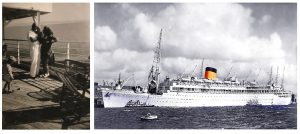
In March 1952 the family came with the repatriation permanently to the Netherlands with the ship the “MS Indrapoera”.
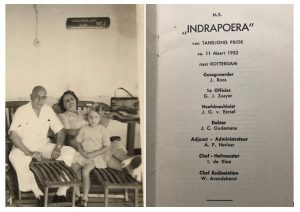
Wim Meuleman worked in the Netherlands as commercial entrepreneur, and his last years as administrative assistant. On the 13th of September 1983 Wim Meuleman died , 84 years old, in Hilversum.
On the 7th of January 1997 Hendrika Theadora Meuleman-Schwägly died, almost 89 years old, in Hoorn.
2). Wilhelmina Cornelia Schwägly, born Rotterdam the 4th of March 1908, she died a half year old, on the 4th of September 1908.
3). Elizabeth Wilhelmina Schwägly, born Rotterdam the 18th of October 1909, she died after three months on the 3rd of January 1910.
4). Franciscus Johannes Petrus (Frans) Schwägly, the son in the family, who could bring the name “Schwägly” into the next generation. He was born in Amsterdam on the 16th of November 1911, (the famliy lived for a short period in Amsterdam, but was in 1913 back in the city of Rotterdam).
After his school time, Frans started to work as cook for the Holland Amerika Line, like his father, who was already working for more than twenty years for the H.A.L.
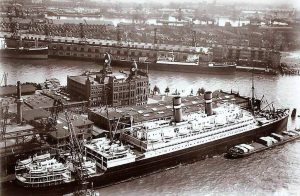
With the age of 24, Frans fell in love with the girlfriend of his younger sister Joke, named Nel Tenholter, (mijn tante, voluit Petronella Johanna Catharina Tenholter), daughter of Henricus Joannes Antonius Tenholter and Antonia Maria Robbeson, (she was born in Rotterdam on the 18th of December 1914). On the 28th of December 1936 Frans and Nel married in Rotterdam.
Nel Schwägly-Tenholter, had worked from the age of 15 (1929) in different hair salons in Rotterdam, and started in 1936 with the sister of Frans; Joke Schwägly a hair salon called “MAISON SCHWAGLY” on the Dordtselaan number 22c in the southern part of Rotterdam.
Frans did not like working anymore for the Holland Amerika Line, he was too long away from home, and of course as a young married couple, Nel did not like it at all. So in 1937, Frans started also working in the hair salon, and Nel learned him hairdressing.
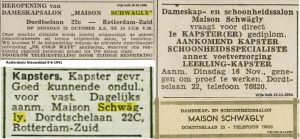
Frans sister Joke stopped working in the hair salon, but it was difficult to find new staff for the hair salon, I found in the news-papers over a period of 15 years more than 30 advertisements for new staff, so the younger sister of Nel; Joke Tenholter was regularly helping in the hair salon untill the year 1942. In the best years of the existence of the hair salon, there were more than six members of staff working.
Before 1946 the hair salon was approx. 18 m2 and there was an apartment from 43 m2 behind the hair salon, in 1946 they enlarged the hair salon, by giving up the apartment, and added the apartment at the hair salon. The re-opening of the new hair salon was in October 1946.
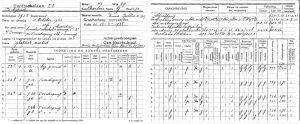
Over a period between 1939 and 1951 Nel gave birth to eight children, five sons and three daughters, unfortunately, it was very sad that three sons died within half a year, (was it because of the poor nutrition due to the war, or was it a hereditary disease? I don’t know).
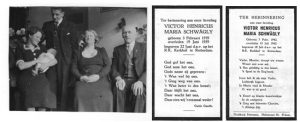
During the Second World War in which Rotterdam was badly affected, business was difficult in the hair salon. There was a period of time that a hair-treatment or haircut became a luxury, and only people who had food in exchange were helped. Because Frans was stealing electricity from German Installations to run the hair salon, he came into prison, but by playing that he was heavily sick, they let him free.
In 1945 at the end of World War 2, the Canadian soldiers had a great share, in what led to the liberation of the Netherlands.
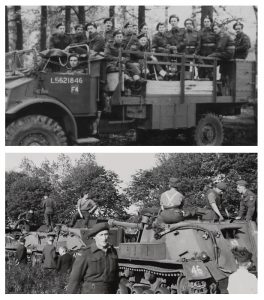
The Canadian soldiers stayed in the Netherlands more than half a year untill February 1946, this created a special bond between the Netherlands and Canada, and in the years after the war, many Dutch sitizens emigrated to Canada in order to build a new live.
And also Frans and Nel Schwägly, emigrated in 1957 with their family to Canada, and landed in the city of Victoria, on Victoria island, an island not far from the city of Vancouver in Britisch Columbia, at the west coast of Canada.
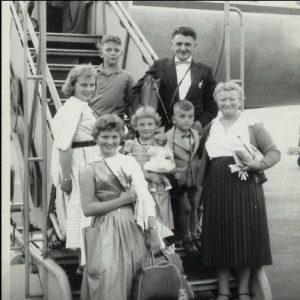
They had to work hard to build a new life in Canada. Nel started again a hair salon and Frans with a restaurant “Chicken Delight”. After three years they moved from Victoria Island to Salt Spring Island, and opened here a “Dutch Beauty Salon”, with Nel and one of her daughters in the salon, and Frans in a footcare and massage clinic.
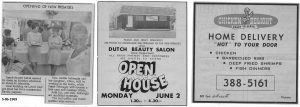
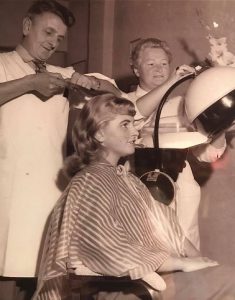
And when business was a succes, there was also money to visit the family and friends in Holland, because Frans and Nel were both a little homesick to Holland, when at home in Canada, and the radio was on, you could hear the Dutch music of the World Service Channel.
.
.
.
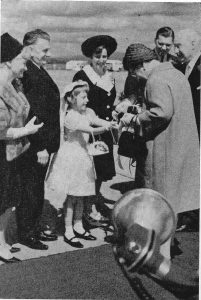
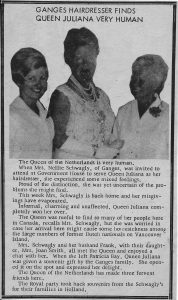
Highlights in those years were the weddings of their five children, and the births of their grandchildren. The visits of their family and friends, who came over from Holland, and alway’s were welcomed with love and care. And not to forget, in 1967 the visit of the Royal Highness Queen Juliana of the Netherlands in Canada, were Nel and her daughter Joan, got the responsibility to take care of the hairstyle of the Queen. And at last all the travelling of the Schwägly’s to Holland.
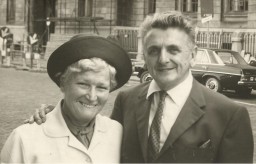
In 1974 Nel celebrated her 45 years in the hairdressing business, and shortly afterwards Frans Schwägly died with the age of 62, (25th of February 1974).
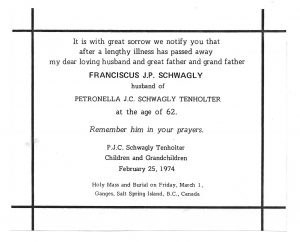
Ten years later on the 7th of January 1984, Nel Schwägly remarried with Frederick Towers Gilman (Fred, born 28th of December 1913 in Ladysmith BC). Fred has been as of 1961 the local hairdresser on Salt Spring Island, and had served in the Canadian Army in Europe during the Second World War.
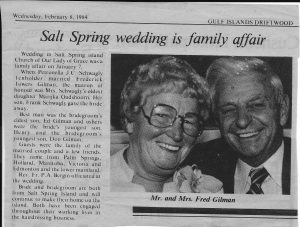
Fred and Nel had a fine time together, and they also came to Holland to visit family and friends and to visit the locations and villages were Fred has been during WW2. Eight years later Fred died in the Royal Jubilee Hospital of Victoria B.C., (on the 16th of August 1992).
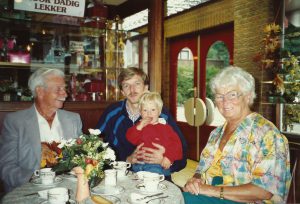
Nel meanwhile 78 years old, stayed in her house on Salt Spring Island, which was possible through the help of her children, but her energy became less. In 2006 when she was 92 years old, she moved to a retirement home called “Dover house” in Nanaimo on Victoria Island B.C.
Five years later on the 28th of November 2011 she died, almost 97 years old in Nanaimo, her five children remained behind, with their spouses and countless grandchildren and great-grandchildren, who are taking care that the name “SCHWAGLY” will continue, in the next generations to come.
According to the EU privacy laws, no information or data is used from the still living generations of Schwägly’s which is only permitted with their permission in writing.
We continue with the three younger sisters of Frans Schwägly:
5). Johanna Francina Schwägly, (Jo,Joke,Jopie) was born in Rotterdam on the 14th of April 1913, she married in 1939 in Rotterdam with Hendrikus Johannes Diks, (Henk, Hennie) who was from profession furniture-seller, (born in Rotterdam 10-4-1905).
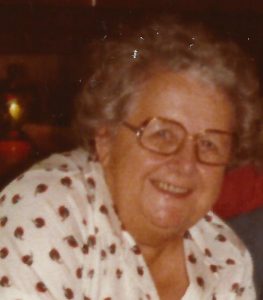
Joke Schwägly and Henk Diks played both with a drama-association called, “R.K.Zuider-Tooneelkring”, this drama association was founded in 1936 and had a great success in Rotterdam. In the newspaper database “Delpherkranten.nl”, I found more than 70 articles, ads and reviews.
The association had R.K., Roman Katholic in their name, because co-founder was Pastor Vijverberg of the Afrikaanderplein-church in the southern part of Rotterdam. They performed not only in their “Verenigingsgebouw” at the Afrikaanderplein, but also in the nearby HBS-school, and in theatre Palace, and the main theatre (grote schouwburg) in the city centre. The number of people that came to their performences downtown was so huge that, according the newspapers, extra trams were used in the evening to transport everyone back to Rotterdam-South. In most of the performences the collected money, for the entrance-tickets went to a good cause.
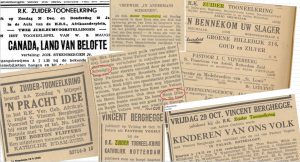
Here some comments from reviews out of the newspapers of the “Maasbode”: 6-4-1937, The drama “In someone else’s shoes”, Nelly Dupont, (mej.Schwägly) was as interpreter verry good, her empathize with and experiencing events was always excellent. 3-10-1938, The drama “The devil and the crumb-mountain”, Alice, (Jo Schwägly) made by her open and uninhibited performance again an irresistible sympathy under the audience. 27-1-1939, The drama, “On the 7th of the 7th”, It was a super story, the audience had to laugh the whole evening. Irene Trevor, played by the very charming miss Joke Schwägly, and mister Henk Diks as Ralph Danby were very good. 31-1-1939, The drama, “In someone else’s shoes”, without shorten the other players we want to mention the performance of miss Jo Schwägly, the way she played the role of “Nelly Dupont” was exceptional. 30-10-1939, The drama, “The Nobility in Livery”, As uncle Henri de Beaucour, Henk Diks surpassed himself this time, and his daughter Maud, played by Jopie Diks-Schwägly was very good.
The “R.K. Zuider Tooneelkring” was a great success, famous actors like Vincent Berghegge was working as actor and director, Jan Bruys, uncle from Joke Bruys actress, singer and comedian, was actor and president, and after the WW2 famous Dutch actors as Ton van Duinhoven, Gerard Cox, Pieter Lutz and Johan van Steenbrugge started their career with the Zuider Tooneelkring.
Untill the year 1940, i found the names of Joke Schwägly and Henk Diks in the newspapers, during the WW2, there was not a lot of time to join the drama association, and Joke and Henk were busy building a family.
From the marriage of Joke and Henk were born two boys and three daughters, the youngest daughter Magda, born the 2nd December 1951, died 40 years old on the 12th of February 1992. Hendrikus Johannes Diks died in Rotterdam on the 16th of April 1980.
Personally I got to know Jopie Diks-Schwägly closer in the years of 1981 untill 1987, when on sunday-mornings we both were doing voluntary work in the Daniel den Hoed hospital in Rotterdam-South, bringing patients with their beds from their department to the hospitals-chapel and back. A turbulent time, patients telling you their fears, concerns, sorrows, and sometimes their whole live story, and a week later you hear, that the patient has past away.
I remembered Jopie Diks Schwägly as a morale, excited woman, full of warmth and humor, “and humor like you can find with every Schwägly”!! Jopie Diks Schwägly died on the 5th of September 1994.
6). Marie Regina (Riet) Schwägly, born Rotterdam the 23rd of January 1918, Riet Schwägly married on the 22nd of November 1939 in Rotterdam with Cornelis Andreas (Cor) van der Veeke, Cor was the son of Jan van der Veeke en Pieternella Verhoef and born in Rotterdam the 3rd of august 1914, as profession was noted in the population register mechanic and gas meter maker. From this marriage were born five children, two sons, and three daughters, one daughter, Johanna Victoria Maria died within a year on the 13th of april 1945.
As of 1965, I was helping, on my free Saterday the local baker, Mr. van Wijngaarden, who drove with a small electric car, filled with bread, cookies and cakes through Tuindorp Vreewijk in Rotterdam, and he brought the groceries to your front door. At that time Cor and Riet van der Veeke were living in the street called “de Boogjes”, and I went with pleasure to the family van der Veeke, and when I rang the bell and Riet opened the front door, she was always friendly and smiling, and her favorites were the cookies, she was always buying them from me! And it was for me and baker van Wijngaarden a game to come home on Saterday evening in the bakery, with every thing sold, so with an empty car, and was there cake or “krentenbollen” left, i often got them home for free from baker van Wijngaarden.
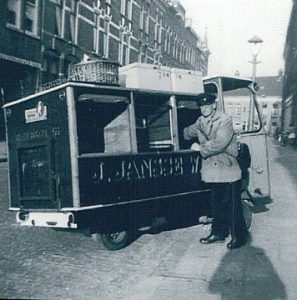
Cor van der Veeke, and Riet van der Veeke-Schwägly both died in the year 2000.
7). Francina Maria Geraldina (Franka ) Schwägly, born in Rotterdam the 19th of December 1922, she married in Rotterdam with Jacobus Bakx on the 8th of September 1943, they devorced two years later on the 17th of September 1945. Around the year 1960 she remarried with Hendrik van Hattem. Francina Maria Geraldina Schwägly died the 28th of February 1974.
These were the seven children of Victor Franciscus Schwägly and Johanna Francina Strijp, the fifth generation of Schwägly’s.
Chapter 10. The search continues.
Here ends the story of the Schwägli’s.
But with searching all sources, you might find more and more puzzle pieces. Here a few puzzle pieces:
From the year 1831 untill 1906 a family Schwägly was living in the St.Urbanngasse nr 31 in Solothurn. At that time lived in this street, a large number of craftsmen, and in regard senior citizen families. As for the craftsmen there were carpenters, tailors, shoemakers and locksmiths, but also a notary and an organ builder.
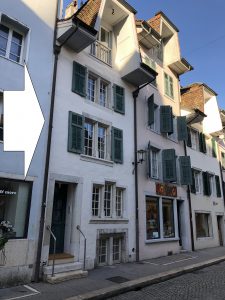
Further I found in an archive of the Solothurner Hans Braun, documents of the Court of Justice of Solothurn from 1820, and having 14 pages about a Johan Schweglij, master-guard, who was responsible for guarding one of the gates of Solothurn, and called “the Bieltor”, and was leading a bataillon soldiers.
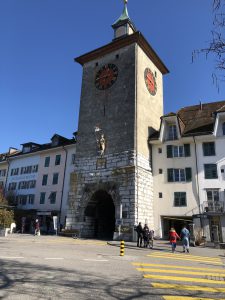
Johan Schweglij had to appear for the Court of Justice, because he had stolen oil from the oil lamps of the Bieltor. He was caught in the act during his service in the night of 20 to 21 June 1820. The complete interview with questions from the Court and the answers of the accused have been documented, including the indictment and the judge’s ruling. Johan Schweglij had 15 days in jail, and he was also put back in function.
Another document I came across in the State archive of the Swiss city of Lucerne, In 1836 a Schwägli from the Swiss place of Langnau entered in the family coat of arms register, see picture below.
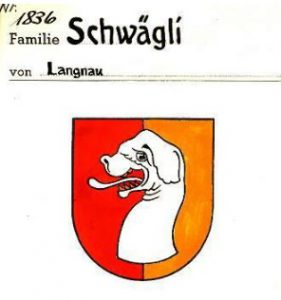
In the 18th century already some 100 Schwägli’s in Solothurn and surrounding villages attended, so it is not strange that there is now, in 2019 still another 50 Schwägli’s in Switzerland living, like a book bindery of Bruno Schwägli, a car garage Schwägli, and a curling Champion Nicole Schwägli.
We have come a long way with the family history of the family “Schwägli,” but we will continue to search, to get the puzzle as complete as possible.

http://www.buchbinder-online.ch/

https://www.garage-schwaegli.ch/
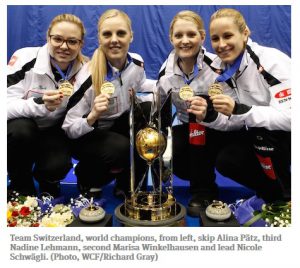
https://en.wikipedia.org/wiki/Nicole_Schw%C3%A4gli
Chapter 11 The Last Witch.
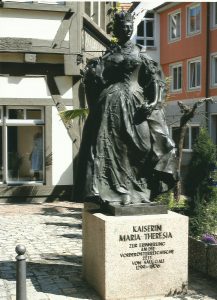
Under the Government of the Austrian Empress Maria Theresia from the House of Habsburg-Lorraine, (1767-1827), we still had terrible trials for witchcraft, in which women were tortured and burned to death as witches.
The last trial for witchcraft in Austria, now territory of Germany concerned the 46 years old “Anna Maria Schwäglin” ( also written as Schwägelin and Schwegelin) poor and sick without famliy and friends she was accused of witchcraft. This took place in 1775 in the Kings-abbey of Kempten. The principality of Kempten was the only land in Europe, where witchcraft and sorcery still was punishable and innocent people were send to the scaffold. This trial had an unexpected end.
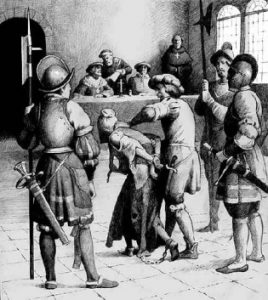
A miserable life.
Anna Maria Schwäglin was born 23 Jan 1729 in Larchen, south of Memmingen in german Allgäu. And she was the daughter of Johannes Schwegle and Anna Blanck. Her birthplace Larchen was under the rule of the Kings-abbot of Kempten. Her parents were rather poor, and they belonged to the lowest level of the village population. Her parents died early, and Anna Maria ended up working as a maid, mainly working on farms and inns in the surrounding area of the city of Memmingen. Around 1751 she met a protestant coach driver who promised to her marriage. But because she was catholic, he made it a condition that she had to convert her religion to the lutheran faith. She did so in the church of Memmingen, but the coach driver ended up breaking his promise and left her for another woman.

Afterwards she quickly regretted the conversion and had repeated self doubts about Gods willingness to forgive her, and she plunged into a deep crises. At that time she claimed later, the devil had appeared to her twice. At the first meeting she had fended off his approach. But at the second she found herself ready to swear off God. She tried unsuccessfully repeatedly to gain relief from her tormenting ideas through confession.
Around 1769 she injured her leg and sick of body and spirit she could no longer pull her normal workload as a maid. In 1769 she was moved to the “Obergünzburger Leprosenhaus” by the authorities of Kempten.
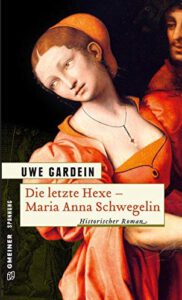
From there they finally transferred her to the Langenegg “Zucht und Arbeitshaus” near Martinszell. There she was repeatedly beaten and deprived of food by one of her fellow inmates. Poor, maltreated, malnourished and guilt-ridden, she became increasingly convinced that in conversing to lutheranism, she had left the protection of the church and the devil was after her. The same woman who had maltreated her, reported her as a witch to the authorities in 1775.
During the interrogations that followed, Anna Maria freely confessed, that she made a pact with the Devil, but had never practiced any black magic, (without torture, that ’s what some sources say, others say she was tortured!).
The verdict was on the 8th of April 1775, convicted to death by the sword and after that her body should be burned.

In 1995, the historian Wolfgang Petz discovered in old church books of the St.Lorenzs-church in Kempten, the note that an “A. Maria Schwägelin” died in 1781, six years after the verdict, in the prison.
So at the end she was not executed. Probable due to the fact, that around the year 1774, in the same city, the wonder-worker and exorcist Johann Joseph Gassner, had written a letter in which he noted that most of the diseases were caused by the devil. And this brought dissension in the Kings-abbey, and they would not dare to execute “the Schwäglein“.

Around 25.000 woman and men were persecuted and killed as alleged witches and sorcerers in early modern Germany. Because the life of the last “witch” in Kempten’s city history has so far been treated more as an amusing anecdote, a group of history-conscious women has been campaigning for a dignified commemoration of the last victim of the witch craze since about 1985.
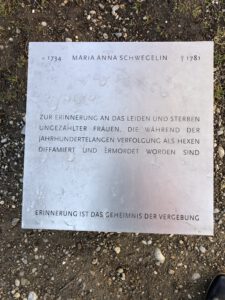
Since 2002, a simple fountain bowl has been dedicated to the Schwegelin, which is located in front of the baroque residence, the former Benedictine monastery and courthouse. On a pedestal next to it, on an inconspicuous memorial plaque, are their life dates and the sentence “In memory of the suffering and death of countless women who were defamed and murdered as witches during centuries of persecution. Memory is the secret of forgiveness.”
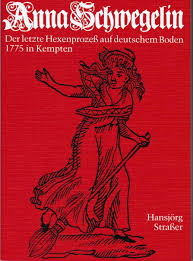
The history of Anna Maria Schwäglin is meanwhile published by different writers, like the book “DIE LETZTE HEXE” (THE LAST WITCH) by Wolfgang Petz and the historical novel by Uwe Gardein, and “ANNA SCHWEGELIN” by Hansjörg Straßer.
The name Schwäglin or Schwägelin is mainly found in Austria and the South of Germany, I could not yet find any relationship or link with the family Schwägly from Switzerland, but I would not withhold you from this “Last Witch”.
Link to the Tourist information of the city of Kempten.
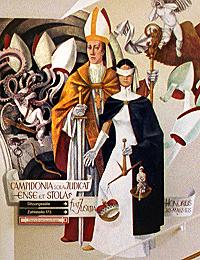
Note: Witchcraft black magic and consulting witches were punishable by death in Europe. In Europe it is estimated that between 30.000 and 60.000 people were murdered during witch persecutions. Half of them on the territory of today’s Germany. The litigations were carried out by secular courts, the indictions came mainly from the population. The accusations included above all the pact with the devil.
In Allgäu, the area where Larchen, Memmingen and Kempten are located were comparatively a few charges against alleged witches. Here too, most of the victems were claimed by the trails during the worst wave of liquidation in the empire between 1570 and 1595. At that time, nine mass-trails took place, each with between 10 and 68 fatalities, namely before the courts of the Prince-bischop of Ausburg, the Bavarian dukes and the imperial city of Kaufbeuren. Not all the trails in Allgäu ended with a death sentence. In total however, about 230 people were executed, 95 percent of them woman!
The Kings-abbey of Kempten conducted only individual lawsuits, most of them late in the 18th century. In some trails, the accusation of witchcraft was joined by others such as murder or arson. In total between 10 and 15 death-sentences for witchcraft offences were handed down in Kings-abbey of Kempten.
In the Netherlands about 250 cases of witch burnings are known. What happened in Europe hundreds of years ago is now happening in parts of Africa. In the modern version of witch persecution, especially vulnerable members of a family, usually women, children, or people with disabilities, are accused of causing adversity with magical powers. That leads to lynchings and beheadings.

And still even today in our world there is shaming of people with witchcraft, like here in the Netherlands, in 2021 PVV-leader Geert Wilders who called Sigrid Kaag, vice Prime Minister and Minister of Finance, on twitter “a witch”. And in the USA in 2015 in Time Magazine, “What is Angela Merkel, a white witch or a mother Theresa?”, (Chancellor of Germany from 2005 to 2021). Also Hillery Clinton was called “the wicked witch of the left” ( First Lady of the United States as the wife of president Bill Clinton from 1993 to 2001). And when in 2013 former Prime Minister Margeret Thatcher died in the U.K., “Ding Dong, The Witch is dead” a song from the Wizard of Oz, topped the charts.
Notes with genealogical data.
Notes of Chapter 1.
1) Ursus Schwägli was born the 18th of Januari 1765 in Oberdorf.
2) The twins were baptized the 20th of Februari 1791 in Oberdorf, witnesses of the baptism were Urs Victor Tsham, Maria Ana Mososchi, born Traxler, Joan Schwägli and Casper Stöckli.
3) Catharina Schwägli married on the 22th of August 1814 in Oberdorf with Ursus Josephus Reinhart.
4) Maria Anna Schwägli born Oberdorf the 7th of November 1793, she died with ten years on the 4th of October 1803.
5) Joannes Hieronymus Schwägli born Oberdorf the 30th of September 1795, he married on the 23rd of October 1820 with Anna Maria Krutter, and he died with the age of 70 the 15th of Januari 1865.
6) Maria Johana Schwägli born in Oberdorf the 17th of March 1803, died 7 months later on the 22nd of October 1803. Her twin-sister Ana Jacobea Schwägli married on the 15th of Februari 1830 with Josephus Studer.
7) Ursula Schwägli married in Oberdorf the 22nd of Februari 1830 with Josephus Elser.
8) Maria Johana Schwägli born Oberdorf the 22nd of December 1807, married on the 22nd of Januari 1827 with Josephus a Burg.
9) Victorinus Schwägli born Oberdorf the 4th of May 1809, baptized the 5th of May 1809, witnesses were Urs Victor Schwägli, and Johanna Walker, both born in Bellach.
Notes of Chapter 3.
10) The internet pages of the library of the University for Science and Technology of Zurich, in a magazine form 1916 for the history of Bern an interesting article about the Swiss soldiers in the Netherlands, ( https://www.e-periodica.ch/digbib/view?pid=bbg-001:1916:12::52#52 ).
Notes of Chapter 4.
11) They married on the 8th of April 1828 Gorinchem, document number 13.
12) Victor Schwägli, born the 20th of December 1828 in Gorinchem, document number 239.
13) Maria Adriana Josephina Schwäglij born th 16th of June 1834 in Willemstad, document number 42.
14) Franciscus Johannes Schwägly, born the 21st of November 1842 in Alkmaar, document number 333.
15) Catharina Ursula Schwägly born the 12th of Februari 1845 in Alkmaar, document number 40.
16) Catharina Ursula Schwägly died the 6th of Januari 1847 in Rotterdam, document number 118
17) Victor Schwägly died the 26st of May 1854, 25 years old in Rotterdam, document number 1326.
18) Urs Victor Schwägly died the 21st of November 1858 in Rotterdam, according to the deceased document number 3027 he was 63 years old, when we substract 1791 from 1858 = 67 years.
19) Marriage document 804 of the 4th 0f November 1863 in Rotterdam, Jacobus Wilhelmus Koenen son of Matthijs Koenen and Catharina Kempen with Maria Adriana Josephina Schwaglij, daughter of Urs Victor Schwaglij and Elisabeth Marosé.
20) Elisabeth Maroos, Marose, died the 13th ofJuly 1866 in Rotterdam, document number 3003.
21) Jacobus Wilhelmus Koenen died the 28th of October 1911 in Rotterdam, document number 4866. Maria Adriana Josephina Schwaglij died the 23rd of December 1912 in Rotterdam, document number 5379. According to the register of population of Rotterdam, they lived on the following adresses between 1905 and 1912: Rosestraat 5, Ammanstraat 5, Tulpstraat 13, Burg.Hoffmanplein 12, en van der Takstraat 25.
Notes of Chapter 5.
22) Victorinus Schwägli was born the 4th of April 1809, and Baptized in the parish church of Oberdorf on the 5th of April.
23) On the 4th of August 1824 Victorinus signed for 6 years as fusilier for the Royal Dutch Army. On the 17th of August, he left Solothurm, and on the 27th of August he arrived at the 32nd Regiment in Holland.
24) On the 6th of Januari 1826 Victorinus was promoted to Corporal, and on the 21st of November 1826 to the rank of Sergeant.
25) On the13th of October 1829 the regiment nr 32 was discontinued.
26) On the 29th of October 1829 Victorinus signed for 6 years for the Royal Dutch Navy.
27) the 15th of March 1830 Victorinus went on board the “H.M.Amstel”, and left the ship on the 1st of August 1830, and went on board the “Heldin” the 9th of September 1830.
28) The award was decorated to Victorinus Schwägli on the 19th of November 1833.
29) On the 3rd of December 1841 the “Juno” left Den Helder, on the 4th of December 1841 it returned to Den Helder, on the 19th of December 1841 the “Juno” left Den Helder, on the 22nd of Januari 1842 the “Juno” reached Suriname. On the 28th of May 1842 the “Juno” was back in Den Helder.
30) The visit of H.M. King William II was on the 4th of August 1842, the news was in the newspapers the on the 8th of August 1842.
31) The squadron returned back to Vlissingen on the 25th of August 1845.
32) Born in Den Helder the 16th of October 1845: Cornelis Johannes Spigt.
33) The 30th of September 1847 the marriage of Victorinus Schwägli and Neeltje Spigt. Neeltje was born in Den Helder the 23rd of July 1820, daughter of Cornelis Pieters Spigt, retired carpenter in the Navy, and Brigitta Gerrits Pot.
34) On the 18th of March 1874 Neeltje Spigt passed away.
35) Information from the register of population of Rotterdam 1860-1880.
36) The 21st of August 1878 , marriage of Victorinus Schwägli and Maria Hansen, she was born in Koedijk the 23rd of June 1821, daughter of Cornelis Hansen and Maria Mezenuf. Widow of Salomon van Tongerlo.
37) Victorinus Schwägli passed away the 2nd of December 1891, Maria Hansen passed away the 7th of May 1892 both in Rotterdam.
Notes of Chapter 6.
38) The marriage was in Rotterdam the 2nd of Januari 1868, Adriana Hendrika Juliana Tas, was born in Rotterdam 26th of March 1846, daughter of Josephus Petrus Tas and Elizabeth Captein.
39) As of 1870 they lived in the Heerenstraat 18, and as of 1875 t’Hang nr. 68.
40) Elizabeth Cecilia Adriana, born 8-6-1868, died 22-4-1871, Josephus Victor Stephanus, born 27-5-1870, died 5-9-1870, Elizabeth Hendrika Maria, born 31-8-1871 stayed alive! Josephina Adriana Hendrika born 6-7-1873, died 8-11-1873, Franciscus Victor born 16-12-1874, died 27-2-1875 and Maria Josephina, born 22-8-1876 died 7-9-1876,
41) In those day, it was normal when a doctor visited the maternity ward, accompanied by the hospital’s head nurse, he would examine the young mothers discreetly by slipping his arm under the sheets, and in between cleaning his hands with the same towel!
42) Hendrica Theodora Stals, daughter of Theodorus Stals and Henrica Machtildes Funnekotter was born in Rotterdam the 18th of September 1846, when she was 22 years old, she married a 26 years old carpenter named Cornelis Gerardes Tempel, the marriage was in Rotterdam on the 30th of June 1869. A half year later (4-1-1870) a son was born: Johannes Theodorus Tempel, four months later (14-5-1870) their son died. On the 30th of October 1870 Hendrica’s husband Cornelis Gerardus Tempel died, and Hendrica was already six months pregnant, so three months later on the 24th of Januari 1871 a daughter was born named: Regina Cornelia Tempel. Hendrica Theodora Stals married on the 7th of March 1877, with Franciscus Johannes Schwägly.
43) A still born girl, on the 30-12-1877, Henrietta Josephina, born 27-2-1879, Victor Franciscus born 12-1-1881, Johanna and Maria born 22-11-1882, Frans Joseph born 4-3-1884, died 1-6-1884, Franciscus born 31-8-1885, died 24-1-1886, A sill born girl on the 25-8-1886 and a still born boy on the 5-9-1887.
44) Franciscus Johannes Schwäglij passed away in Rotterdam the 28th of June 1920.
45) Hendrica Theodora Stals passes away in Rotterdam-Hillegersberg, the first of Janauary 1936
Notes of Chapter 7.
46) Regina Cornelia Tempel married in Rotterdam on the 27th of May 1896.
47) Henrietta Josephina Schwägly married on the 13th of September 1905 with Christianus Theodorus van Overbeek. They divorced after six years on the 23th of November 1911. Henrietta Josephina Schwägly moved from Rotterdam on the 1st of Nevember 1999 to Amsterdam to the Reguliersbreestraat 34 and started to work in the ladies fashion shop of Bokeloh & Determeyer. she went back to Rotterdam (Feyenoordstraat 21) on the 28th of January 1901. In the newspapers (Delpherkranten.nl) you can find a lot of information about the ins and outs of the company Determeyer.
48) From September 1910 untill November 1911 was Elizabeth Hendrika Maria Schwägly in Germany, we don’t know exactly were she went, but a fact is that two sisters of Christianus Theodorus van Overbeek had a fashion boutique in Germany.
49) Elisabeth H.M. Schwägly arrived at New York (Ellis-Island), with the SS Rotterdam on the 14th of April 1914.
50) Articles from the New York Tribune from 4th and 5th of July 1918, and from the New York Sun from the 6th of July 1918.
51) Elisabeth H.M.Schwägly passed away in Den Haag on the 18th of May 1949, Henrietta Josephina Schwägly passed away in Den Haag on the 24th of July 1960.
Notes of Chapter 8.
52) Rotterdam 13-9-1905, marriage between Christianus Theodorus van Overbeek, son of Hendricus van Overbeek and Engelina Frederika van Lieshout, and Henrietta Josephina Schwägly, daughter of Franciscus Johannes Schwägly and Hendrica Theodora Stals. ( document 1905-page L27v, cert.2025).
Rotterdam 21-12-1911, By judgment of the district court of Rotterdam is the marriage between Christianus Theodorus van Overbeek and Henrietta Josephina Schwägly dissolved by divorce, (document 1911, page 119, cert. 199).
In the divorce document, is at the request of Henrietta Josephina Schwägly, a judgment of the district court of Rotterdam, here presented for registration, in absentia, on 23-11-1911. The marriage was dissolved by divorce on the basis of adultery committed by Christianus Theodorus van Overbeek. No objection has been lodged against the above-mentioned judgment.
53) Marriage 1, in Poortugaal on the 23rd of April 1875 (cert. 5) of Hendricus van Overbeek and Elisabeth van der Poel. Mariage 2. in Rotterdam on the 26th of May 1880 (cert. 485) of Hendricus van Overbeek and Engelina Frederika van Lieshout.
Hendricus van Overbeek, born Rhoon 18-4-1852 (cert. 17), and passed away, Rotterdam 3-9-1911 (cert. 3957).
Elisabeth van der Poel, born Poortugaal 16-10-1850, (cert. 36), and passed away, Poortugaal 4-12-1879, (cert. 35).
Engelina Frederika van Lieshout, born Kralingen 15-9-1850 (cert. 104), and passed away Rotterdam 24-3-1928, (cert. 1544).
54) Christina Stijntje Vreezen, born Rotterdam 30-6-1889, (cert. 3412), daughter of Willem Lodewijk Vreezen and Maartje van Rijn, she passed away , 27 years old, in Rotterdam 11-11-1916, (cert. 5174).
55) Johanna Flaes, born Rotterdam 7-11-1898 , (cert. 9417), daughter of Dirk Flaes and Johanna Smits.
56) Christianus Theodorus van Overbeek, born Delfshaven, 31-3-1882, (cert. 163), son of Hendricus van Overbeek and Engelina Frederica van Lieshout, Marriage Rotterdam 13-9-1905 (cert.2025) with Henrietta Josephina Schwägly, divorced Rotterdam 21-12-1911, (cert.199).
57) Victor Franciscus Schwäglij was born the 12th of January 1881 in Delfshaven, (cert. 22).
58) Victor Franciscus Schwäglij married on the 14th of February 1906 in Rotterdam with Johanna Francina Strijp,( cert. 1906B-b69v), she was born on the 19th of August 1884 in Rotterdam, daughter of Peter Strijp and Wilhelmina Cornelia van der Ven, (cert.1884D-d110v -4131).
59) Hendrica Theodora Schwäglij (Jet) was born in Rotterdam on the 23rd of February 1907 (cert. 1907-2100 page d065).
60) Wilhelmina Cornelia Schwäglij was born in Rotterdam on the 4th of March 1908 (cert. 1908-2605 page C128v) and died in Rotterdam on the 4th of September 1908 (cert. 1908-4286 page d180).
61) Elizabeth Wilhelmina Schwäglij was born in Rotterdam on the 18th of October 1909 (cert. 1909-10505 page n121), she died in Rotterdam on the 3rd of January 1910 (cert.1910-55 page a006v).
62) The family lived in Amsterdam from 3rd of January 1910 until the 2nd of September 1911, on the Beverstraat 24, Balistraat 112 and the Javastraat 59. Franciscus Johannes Petrus Schwäglij was born in Amsterdam on the 16th of November 1911.
63) Johanna Francina Schwäglij (Jo -Joke -Jopie) was born in Rotterdam on the 14th of April 1913. Maria Regina Schwäglij (Riet) was born in Rotterdam on the 23rd of January 1918.
64) Francina Maria Geraldina Schwäglij (Franca) was born in Rotterdam on the 19th of December 1922.
65) K.P.M. = Koninklijke Paketvaart Maatschappij, was a major Dutch shipping company, that maintained the sea connections between the islands of Indonesia (formely Netherlands East Indies or NEI ) and later expanded its services also to Australia, New Zealand and Afrika.
66) Johanna Francina Strijp died on the 27th of April 1951 in Rotterdam.
67) Johanna Schwäglij born Rotterdam 22-11-1882 married 17-7-1907 in Rotterdam with Adrianus Gerardus Hollaardt, an office worker, and later confidential clerck, born in Rotterdam 16-2-1883, son of Adrianus Gerardus Hollaardt and Maria Elizabeth van Teeffelen. Adrianus Gerardus Hollaardt died in Rotterdam 2-6-1946), Johanna Schwägly died, old 73 years in Den Haag on the 8th of January 1956,( cert. B58).
68) Maria Schwäglij, was born in R otterdam 22-11-1882, Maria Schwäglij was Married in Rotterdam 31-12-1912, (acte 3587) with Gerardus Philippus Heijberg, who was born in Rotterdam 26-10-1887, son of August Heijberg and Johanna Maria Pieternella de Bluts. Gerardus Philippus. In the marriage document was noted that Gerardus Philippus Heijberg was clerk at the postal and telegraphic services. and his father director of a funeral home.
Hereinafter the brothers and sisters of Gerardus Philippus Heijberg:
Johannes August Heijberg, born Rotterdam 26-8-1874 (acte 3437), died Rotterdam 5-11-1874 (acte 3531).
August Heijberg, born Rotterdam 17-3-1876 (acte 1205), married Rotterdam 2-11-1899 (acte LV2) with Elisabeth Jansje Overgaauw.
Johanna Maria Elisabeth (Jo) Heijberg, born Rotterdam 22-4-1878 (acte 1780), married Rotterdam 24-11-1904 (acte N43) with Pierre Guillaume Charles Jaques.
Johannes Josephus (Jan) Heijberg, born Rotterdam 11-6-1879 (acte 2691), married Rotterdam 10-3-1909 (acte 06-d23) with Jacoba van Ree.
Jacobus Phiippus Heijberg, born Rotterdam 20-9-1880 (acte 4264), died Rotterdam 19-12-1880 (acte 3973).
Jacobus Philippus Heijberg, born Rotterdam 13-6-1882 (acte 2891), died 27-8-1882 (acte 2729).
Jacobus Philippus (Koos) Heijberg, born Rotterdam 14-4-1884 (acte 1914) married Rotterdam 17-7-1907 (acte i41) with Hermina Cornelia den Haan.
Hillegonda Elizabeth (Gonda) Heijberg, born Rotterdam 24-6-1889 (acte 3324) married Rotterdam 3-7-1913 (acte K99) with Philippus van de Wetering.
Henrietta Maria (Jet) Heijberg, born Rotterdam 28-5-1891 (acte 3073) married Rotterdam 19-5-1921 (acte n14) with Bastiaan Hendrik Louis Coenraad Bal.
Maria Wendelina Arnolda (Marie) Heijberg, born Rotterdam 26-11-1894.
On the 2nd of January 1913 Marie and Gerardus left for Batavia. On the 4th of April 1913 Maria Schwäglij had a stillborn child.
69) On the 17th of September 1914 Hendrica Johanna Maria, called Henny Heijberg was born in Weltevreden (Weltevreden was a European-inhabited suburb of Batavia (the current Indonesian capital Jakarta) in Dutch colonial times, located about 10 kilometers southeast of the city center. It is now known as Jakarta Pusat, Central Jakarta).
70) Maria Schwäglij divorced on the 12th of August 1020 in Batavia.
71) According to the register of occupation Henny was living from 6-5-1921 at the Beeklaan 309A in The Hague. and as of 16-2-1922 she moved to the 1e Middellandstraat 25B in Rotterdam. She was living here with August Heijberg and Elisabeth Jansje Overgaauw.
72) On the 9th of June 1921 Maria Schwäglij married in Rotterdam with Petrus Philipp, which was born in Vlissingen on the 12-9-1887, son of Wilhelm Philipp and Theodora Johanna Clerks.
73) According to the register of population of Rotterdam, Henny went on the 10th of January 1929 to a girls-boardingschool (Meisjes kostschool van de Evangelische Broedergemeente in Zeist met onderwijs voor M.U.L.O. en Lyceum).
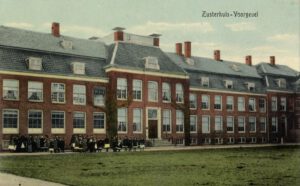
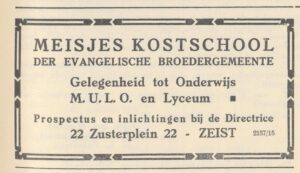
Notes of Chapter 9.
Notes of Chapter 10.
wordt vervolgd
Wilt U terug naar top pagina klik op deze link.
The Statue of Liberty – Ellis Island Foundation Passenger Search Link:
Wilt U terug naar top pagina klik op deze link.

